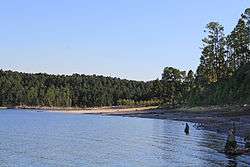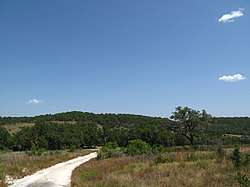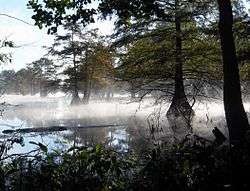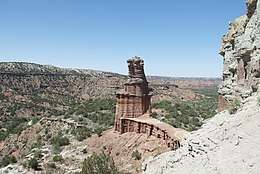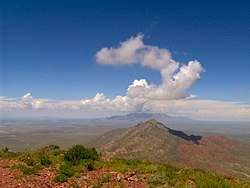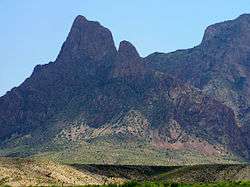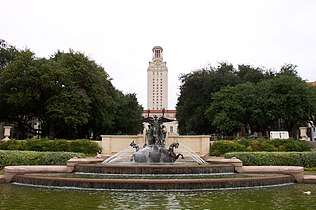Texas
Texas (/ˈtɛksəs/, also locally /ˈtɛksɪz/;[10] Spanish: Texas or Tejas, pronounced [ˈtexas] (![]()
Texas | |
|---|---|
| State of Texas | |
| Nickname(s): The Lone Star State | |
| Motto(s): Friendship | |
| Anthem: "Texas, Our Texas" | |
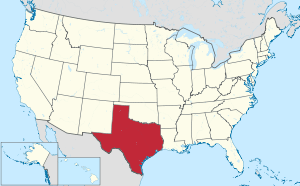 Map of the United States with Texas highlighted | |
| Country | United States |
| Before statehood | Republic of Texas |
| Admitted to the Union | December 29, 1845 (28th) |
| Capital | Austin |
| Largest city | Houston |
| Largest metro | Dallas–Fort Worth Metroplex |
| Government | |
| • Governor | Greg Abbott (R) |
| • Lieutenant Governor | Dan Patrick (R) |
| Legislature | Texas Legislature |
| • Upper house | Senate |
| • Lower house | House of Representatives |
| Judiciary | Supreme Court of Texas (Civil) Texas Court of Criminal Appeals (Criminal) |
| U.S. senators | John Cornyn (R) Ted Cruz (R) |
| U.S. House delegation | 23 Republicans 13 Democrats (list) |
| Area | |
| • Total | 268,596[1] sq mi (695,662 km2) |
| • Land | 261,232[1] sq mi (676,587 km2) |
| • Water | 7,365[1] sq mi (19,075 km2) 2.7% |
| Area rank | 2nd |
| Dimensions | |
| • Length | 801[2] mi (1,289 km) |
| • Width | 773[2] mi (1,244 km) |
| Elevation | 1,700 ft (520 m) |
| Highest elevation | 8,751 ft (2,667.4 m) |
| Lowest elevation | 0 ft (0 m) |
| Population (2019) | |
| • Total | 28,995,881[6][7] |
| • Rank | 2nd |
| • Density | 108/sq mi (40.6/km2) |
| • Density rank | 26th |
| • Median household income | $59,206[8] |
| • Income rank | 24th |
| Demonym(s) | Texan Texian (archaic) Tejano (usually only used for Hispanics) |
| Language | |
| • Official language | No official language (see Languages spoken in Texas) |
| • Spoken language | Predominantly English; Spanish is spoken by a sizable minority[9] |
| Time zones | |
| Majority of state | UTC−06:00 (Central) |
| • Summer (DST) | UTC−05:00 (CDT) |
| El Paso, Hudspeth, and northwestern Culberson counties | UTC−07:00 (Mountain) |
| • Summer (DST) | UTC−06:00 (MDT) |
| USPS abbreviation | TX |
| ISO 3166 code | US-TX |
| Trad. abbreviation | Tex. |
| Latitude | 25°50′ N to 36°30′ N |
| Longitude | 93°31′ W to 106°39′ W |
| Website | texas |
| Texas state symbols | |
|---|---|
 | |
 | |
| Living insignia | |
| Bird | Northern mockingbird (Mimus polyglottos) |
| Fish | Guadalupe bass (Micropterus treculii) |
| Flower | Bluebonnet (Lupinus spp., namely Texas bluebonnet, L. texensis) |
| Insect | Monarch butterfly (Danaus plexippus) |
| Mammal | Texas longhorn, nine-banded armadillo (Dasypus novemcinctus) |
| Reptile | Texas horned lizard (Phrynosoma cornutum) |
| Tree | Pecan (Carya illinoinensis) |
| Inanimate insignia | |
| Food | Chili |
| Instrument | Guitar |
| Shell | Lightning whelk (Busycon perversum pulleyi) |
| Ship | USS Texas |
| Slogan | The Friendly State |
| Soil | Houston Black |
| Sport | Rodeo |
| Other | Molecule: Buckyball (For more, see article) |
| State route marker | |
 | |
| State quarter | |
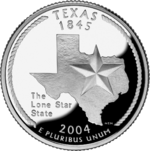 Released in 2004 | |
| Lists of United States state symbols | |
Houston is the most populous city in Texas and the fourth largest in the U.S., while San Antonio is the second-most populous in the state and seventh largest in the U.S. Dallas–Fort Worth and Greater Houston are the fourth and fifth largest metropolitan statistical areas in the country, respectively. Other major cities include Austin, the second-most populous state capital in the U.S., and El Paso. Texas is nicknamed the "Lone Star State" for its former status as an independent republic, and as a reminder of the state's struggle for independence from Mexico. The "Lone Star" can be found on the Texas state flag and on the Texas state seal.[11] The origin of Texas's name is from the word táyshaʼ, which means "friends" in the Caddo language.[12]
Due to its size and geologic features such as the Balcones Fault, Texas contains diverse landscapes common to both the U.S. Southern and the Southwestern regions.[13] Although Texas is popularly associated with the U.S. southwestern deserts, less than ten percent of Texas's land area is desert.[14] Most of the population centers are in areas of former prairies, grasslands, forests, and the coastline. Traveling from east to west, one can observe terrain that ranges from coastal swamps and piney woods, to rolling plains and rugged hills, and finally the desert and mountains of the Big Bend.
The term "six flags over Texas"[note 1] refers to several nations that have ruled over the territory. Spain was the first European country to claim and control the area of Texas. France held a short-lived colony. Mexico controlled the territory until 1836 when Texas won its independence, becoming an independent republic. In 1845,[15] Texas joined the union as the 28th state. The state's annexation set off a chain of events that led to the Mexican–American War in 1846. A slave state before the American Civil War, Texas declared its secession from the U.S. in early 1861, and officially joined the Confederate States of America on March 2 of the same year. After the Civil War and the restoration of its representation in the federal government, Texas entered a long period of economic stagnation.
Historically four major industries shaped the Texas economy prior to World War II: cattle and bison, cotton, timber, and oil.[16] Before and after the U.S. Civil War the cattle industry, which Texas came to dominate, was a major economic driver for the state, thus creating the traditional image of the Texas cowboy. In the later 19th century cotton and lumber grew to be major industries as the cattle industry became less lucrative. It was ultimately, though, the discovery of major petroleum deposits (Spindletop in particular) that initiated an economic boom which became the driving force behind the economy for much of the 20th century. With strong investments in universities, Texas developed a diversified economy and high tech industry in the mid-20th century. As of 2015, it is second on the list of the most Fortune 500 companies with 54.[17] With a growing base of industry, the state leads in many industries, including tourism, agriculture, petrochemicals, energy, computers and electronics, aerospace, and biomedical sciences. Texas has led the U.S. in state export revenue since 2002 and has the second-highest gross state product. If Texas were a sovereign state, it would be the 10th largest economy in the world.
Etymology
The name Texas, based on the Caddo word táyshaʼ (/t'ajʃaʔ/) "friend", was applied, in the spelling Tejas or Texas,[18] by the Spanish to the Caddo themselves, specifically the Hasinai Confederacy,[19] the final -s representing the Spanish plural.[20] The Mission San Francisco de los Tejas was completed near the Hasinai village of Nabedaches in May 1690, in what is now Houston County, East Texas.[21]
During Spanish colonial rule, in the 18th century, the area was known as Nuevas Filipinas ("New Philippines") and Nuevo Reino de Filipinas ("New Kingdom of the Philippines"),[22] or as provincia de los Tejas ("province of the Tejas"),[23] later also provincia de Texas (or de Tejas), ("province of Texas").[24][22] It was incorporated as provincia de Texas into the Mexican Empire in 1821, and declared a republic in 1836. The Royal Spanish Academy recognizes both spellings, Tejas and Texas, as Spanish-language forms of the name of the U.S. State of Texas.[25]
The English pronunciation with /ks/ is unetymological, and based in the value of the letter x in historical Spanish orthography. Alternative etymologies of the name advanced in the late 19th century connected the Spanish teja "rooftile", the plural tejas being used to designate indigenous Pueblo settlements.[26] A 1760s map by Jacques-Nicolas Bellin shows a village named Teijas on Trinity River, close to the site of modern Crockett.[26]
Geography
Texas is the second-largest U.S. state, after Alaska, with an area of 268,820 square miles (696,200 km2). Though 10% larger than France and almost twice as large as Germany or Japan and more than twice the size of the United Kingdom, it ranks only 27th worldwide amongst country subdivisions by size. If it were an independent country, Texas would be the 40th largest behind Chile and Zambia.
Texas is in the south central part of the United States of America. Three of its borders are defined by rivers. The Rio Grande forms a natural border with the Mexican states of Chihuahua, Coahuila, Nuevo León, and Tamaulipas to the south. The Red River forms a natural border with Oklahoma and Arkansas to the north. The Sabine River forms a natural border with Louisiana to the east. The Texas Panhandle has an eastern border with Oklahoma at 100° W, a northern border with Oklahoma at 36°30' N and a western border with New Mexico at 103° W. El Paso lies on the state's western tip at 32° N and the Rio Grande.[27]
With 10 climatic regions, 14 soil regions and 11 distinct ecological regions, regional classification becomes problematic with differences in soils, topography, geology, rainfall, and plant and animal communities.[28] One classification system divides Texas, in order from southeast to west, into the following: Gulf Coastal Plains, Interior Lowlands, Great Plains, and Basin and Range Province.
The Gulf Coastal Plains region wraps around the Gulf of Mexico on the southeast section of the state. Vegetation in this region consists of thick piney woods. The Interior Lowlands region consists of gently rolling to hilly forested land and is part of a larger pine-hardwood forest.
The Great Plains region in central Texas spans through the state's panhandle and Llano Estacado to the state's hill country near Austin. This region is dominated by prairie and steppe. "Far West Texas" or the "Trans-Pecos" region is the state's Basin and Range Province. The most varied of the regions, this area includes Sand Hills, the Stockton Plateau, desert valleys, wooded mountain slopes and desert grasslands.
Texas has 3,700 named streams and 15 major rivers,[29][30] with the Rio Grande as the largest. Other major rivers include the Pecos, the Brazos, Colorado, and Red River. While Texas has few natural lakes, Texans have built more than a hundred artificial reservoirs.[31]
The size and unique history of Texas make its regional affiliation debatable; it can be fairly considered a Southern or a Southwestern state, or both. The vast geographic, economic, and cultural diversity within the state itself prohibits easy categorization of the whole state into a recognized region of the United States. Notable extremes range from East Texas which is often considered an extension of the Deep South, to Far West Texas which is generally acknowledged to be part of the interior Southwest.[32]
Geology
Texas is the southernmost part of the Great Plains, which ends in the south against the folded Sierra Madre Occidental of Mexico. The continental crust forms a stable Mesoproterozoic craton which changes across a broad continental margin and transitional crust into true oceanic crust of the Gulf of Mexico. The oldest rocks in Texas date from the Mesoproterozoic and are about 1,600 million years old.
These Precambrian igneous and metamorphic rocks underlie most of the state, and are exposed in three places: Llano uplift, Van Horn, and the Franklin Mountains, near El Paso. Sedimentary rocks overlay most of these ancient rocks. The oldest sediments were deposited on the flanks of a rifted continental margin, or passive margin that developed during Cambrian time.
This margin existed until Laurasia and Gondwana collided in the Pennsylvanian subperiod to form Pangea. This is the buried crest of the Appalachian Mountains–Ouachita Mountains zone of Pennsylvanian continental collision. This orogenic crest is today buried beneath the Dallas–Waco—Austin–San Antonio trend.
The late Paleozoic mountains collapsed as rifting in the Jurassic period began to open the Gulf of Mexico. Pangea began to break up in the Triassic, but seafloor spreading to form the Gulf of Mexico occurred only in the mid- and late Jurassic. The shoreline shifted again to the eastern margin of the state and the Gulf of Mexico's passive margin began to form. Today 9 to 12 miles (14 to 19 km) of sediments are buried beneath the Texas continental shelf and a large proportion of remaining US oil reserves are here. At the start of its formation, the incipient Gulf of Mexico basin was restricted and seawater often evaporated completely to form thick evaporite deposits of Jurassic age. These salt deposits formed salt dome diapirs, and are found in East Texas along the Gulf coast.[33]
East Texas outcrops consist of Cretaceous and Paleogene sediments which contain important deposits of Eocene lignite. The Mississippian and Pennsylvanian sediments in the north; Permian sediments in the west; and Cretaceous sediments in the east, along the Gulf coast and out on the Texas continental shelf contain oil. Oligocene volcanic rocks are found in far west Texas in the Big Bend area. A blanket of Miocene sediments known as the Ogallala formation in the western high plains region is an important aquifer.[34] Located far from an active plate tectonic boundary, Texas has no volcanoes and few earthquakes.[35]
Wildlife
A wide range of animals and insects live in Texas. It is the home to 65 species of mammals, 213 species of reptiles and amphibians, and the greatest diversity of bird life in the United States—590 native species in all.[36] At least 12 species have been introduced and now reproduce freely in Texas.[37]
Texas plays host to several species of wasps, including an abundance of Polistes exclamans,[38] and is an important ground for the study of Polistes annularis.
During the spring Texas wildflowers such as the state flower, the bluebonnet, line highways throughout Texas. During the Johnson Administration the first lady, Lady Bird Johnson, worked to draw attention to Texas wildflowers.
Climate

The large size of Texas and its location at the intersection of multiple climate zones gives the state highly variable weather. The Panhandle of the state has colder winters than North Texas, while the Gulf Coast has mild winters. Texas has wide variations in precipitation patterns. El Paso, on the western end of the state, averages 8.7 inches (220 mm) of annual rainfall,[39] while parts of southeast Texas average as much as 64 inches (1,600 mm) per year.[40] Dallas in the North Central region averages a more moderate 37 inches (940 mm) per year.
Snow falls multiple times each winter in the Panhandle and mountainous areas of West Texas, once or twice a year in North Texas, and once every few years in Central and East Texas. Snow falls south of San Antonio or on the coast only in rare circumstances. Of note is the 2004 Christmas Eve snowstorm, when 6 inches (150 mm) of snow fell as far south as Kingsville, where the average high temperature in December is 65 °F.[41]
Maximum temperatures in the summer months average from the 80s °F (26 °C) in the mountains of West Texas and on Galveston Island to around 100 °F (38 °C) in the Rio Grande Valley, but most areas of Texas see consistent summer high temperatures in the 90 °F (32 °C) range.
Night-time summer temperatures range from the upper 50s °F (14 °C) in the West Texas mountains[42] to 80 °F (27 °C) in Galveston.[43]
The table below consists of averages for August (generally the warmest month) and January (generally the coldest) in selected cities in various regions of the state. El Paso and Amarillo are exceptions with July and December respectively being the warmest and coldest months respectively, but with August and January being only narrowly different.
| Location | August (°F) | August (°C) | January (°F) | January (°C) |
|---|---|---|---|---|
| Houston | 94/75 | 34/24 | 63/54 | 17/12 |
| San Antonio | 96/74 | 35/23 | 63/40 | 17/5 |
| Dallas | 96/77 | 36/25 | 57/37 | 16/3 |
| Austin | 97/74 | 36/23 | 61/45 | 16/5 |
| El Paso | 92/67 | 33/21 | 57/32 | 14/0 |
| Laredo | 100/77 | 37/25 | 67/46 | 19/7 |
| Amarillo | 89/64 | 32/18 | 50/23 | 10/−4 |
| Brownsville | 94/76 | 34/24 | 70/51 | 21/11 |
Storms
Thunderstorms strike Texas often, especially the eastern and northern portions of the state. Tornado Alley covers the northern section of Texas. The state experiences the most tornadoes in the United States, an average of 139 a year. These strike most frequently in North Texas and the Panhandle.[45] Tornadoes in Texas generally occur in the months of April, May, and June.[46]
Some of the most destructive hurricanes in U.S. history have impacted Texas. A hurricane in 1875 killed about 400 people in Indianola, followed by another hurricane in 1886 that destroyed the town. These events allowed Galveston to take over as the chief port city. The 1900 Galveston hurricane subsequently devastated that city, killing about 8,000 people or possibly as many as 12,000. This makes it the deadliest natural disaster in U.S. history.[47] In 2017, Hurricane Harvey made landfall in Rockport as a Category 4 Hurricane, causing significant damage there. The storm stalled over land for a very long time, allowing it to drop unprecedented amounts of rain over the Greater Houston area and surrounding counties. The result was widespread and catastrophic flooding that inundated hundreds of thousands of homes. Harvey ultimately became the costliest hurricane worldwide, causing an estimated $198.6 billion in damage, surpassing the cost of Hurricane Katrina.[48]
Other devastating Texas hurricanes include the 1915 Galveston hurricane, Hurricane Audrey in 1957 which killed more than 600 people, Hurricane Carla in 1961, Hurricane Beulah in 1967, Hurricane Alicia in 1983, Hurricane Rita in 2005, and Hurricane Ike in 2008. Tropical storms have also caused their share of damage: Allison in 1989 and again during 2001, and Claudette in 1979 among them.
Greenhouse gases
As of 2017 Texas emits the most greenhouse gases in the U.S, almost twice the amount of California, the second most polluting state.[49] As of 2017 the state emits about 1,600 billion pounds (707 million metric tons) of carbon dioxide annually.[49] As an independent nation, Texas would rank as the world's seventh-largest producer of greenhouse gases.[50] Causes of the state's vast greenhouse gas emissions include the state's large number of coal power plants and the state's refining and manufacturing industries.[50] In 2010, there were 2,553 "emission events" which poured 44.6 million pounds (20,200 metric tons) of contaminants into the Texas sky.[51]
History
Pre-European era
Part of a series on the |
||||||||||||||||||
|---|---|---|---|---|---|---|---|---|---|---|---|---|---|---|---|---|---|---|
| History of Texas | ||||||||||||||||||
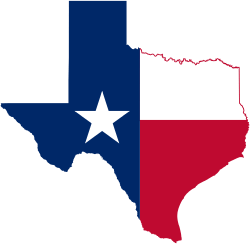 | ||||||||||||||||||
| Timeline | ||||||||||||||||||
|
||||||||||||||||||
|
| ||||||||||||||||||
Texas lies between two major cultural spheres of Pre-Columbian North America: the Southwestern and the Plains areas. Archaeologists have found that three major indigenous cultures lived in this territory, and reached their developmental peak before the first European contact. These were:[52]
- the Pueblo from the upper Rio Grande region, centered west of Texas;
- the Mississippian culture, also known as Mound Builders, which extended along the Mississippi River Valley east of Texas; and
- the civilizations of Mesoamerica, centered south of Texas. Influence of Teotihuacan in northern Mexico peaked around AD 500 and declined over the 8th to 10th centuries.
When Europeans arrived in the Texas region, there were several races of Native peoples divided into many smaller tribes. They were Caddoan, Atakapan, Athabaskan, Coahuiltecan, and Uto-Aztecan. The Uto-Aztecan Puebloan peoples lived neared the Rio Grande in the western portion of the state, the Athabaskan-speaking Apache tribes lived throughout the interior, the Caddoans controlled much of the Red River region and the Atakapans were mostly centered along the Gulf Coast. At least one tribe of Coahuiltecans, the Aranama, lived in southern Texas. This entire culture group, primarily centered in northeastern Mexico, is now extinct. It is difficult to say who lived in the northwestern region of the state originally. By the time the region came to be explored, it belonged to the fairly well-known Comanche, another Uto-Aztecan people who had transitioned into a powerful horse culture, but it is believed that they came later and did not live there during the 16th century. It may have been claimed by several different peoples, including Uto-Aztecans, Athabaskans, or even Dhegihan Siouans.
No culture was dominant in the present-day Texas region, and many peoples inhabited the area.[52] Native American tribes who lived inside the boundaries of present-day Texas include the Alabama, Apache, Atakapan, Bidai, Caddo, Aranama, Comanche, Choctaw, Coushatta, Hasinai, Jumano, Karankawa, Kickapoo, Kiowa, Tonkawa, and Wichita.[53][54] The name Texas derives from táyshaʔ, a word in the Caddoan language of the Hasinai, which means "friends" or "allies".[1][55][56][57][58]
The region was primarily controlled by the Spanish for the first couple centuries of contact, until the Texas Revolution. They were not particularly kind to their native populations—even less so with the Caddoans, who were not trusted as their culture was split between the Spanish and the French. When the Spanish briefly managed to conquer the Louisiana colony, they decided to switch tactics and attempt being exceedingly friendly to the Indians, which they continued even after the French took back the colony. After the 1803 Louisiana Purchase, the United States inherited this odd circumstance. The Caddoans preferred the company of Americans and almost the entire population of them migrated into the states of Louisiana and Arkansas. The Spanish felt jilted after having spent so much time and effort and began trying to lure the Caddo back, even promising them more land. Seemingly without actually knowing how they came by it, the United States (who had begun convincing tribes to self-segregate from whites by selling everything and moving west ever since they gained the Louisiana Purchase) faced an overflow of native peoples in Missouri and Arkansas and were able to negotiate with the Caddoans to allow several displaced peoples to settle on unused lands in eastern Texas. They included the Muscogee, Houma Choctaw, Lenape and Mingo Seneca, among others, who all came to view the Caddoans as saviors, making those peoples highly influential.[59][60]
Whether a Native American tribe was friendly or warlike was critical to the fates of European explorers and settlers in that land.[61] Friendly tribes taught newcomers how to grow indigenous crops, prepare foods, and hunt wild game. Warlike tribes made life difficult and dangerous for Europeans through their attacks and resistance to the newcomers.[62]
During the Texas Revolution, the U.S. became heavily involved. Prior treaties with the Spanish forbade either side from militarizing its native population in any potential conflict between the two nations. At that time, several sudden outbreaks of violence between Caddoans and Texans started to spread. The Caddoans were always clueless when questioned, The Texan and American authorities in the region could never find hard evidence linking them to it and often it was so far-flung from Caddoan lands, it barely made any sense. It seems most likely that these were false-flag attacks meant to start a cascading effect to force the natives under Caddoan influence into armed conflict without breaking any treaties—preferably on the side of the Spanish. While no proof was found as to who the culprit was, those in charge of Texas at the time attempted multiple times to publicly blame and punish the Caddoans for the incidents with the U.S. government trying to keep them in check. Furthermore, the Caddoans never turned to violence because of it, excepting cases of self-defense.[59]
By the 1830s, the U.S. had drafted the Indian Removal Act, which was used to facilitate the Trail of Tears. Fearing retribution of other native peoples, Indian Agents all over the eastern U.S. began desperately trying to convince all their native peoples to uproot and move west. This included the Caddoans of Louisiana and Arkansas. Following the Texas Revolution, the Texans chose to make peace with their Native peoples but did not honor former land claims or agreements. This began the movement of Native populations north into what would become Indian Territory—modern-day Oklahoma.[59]
Colonization

The first historical document related to Texas was a map of the Gulf Coast, created in 1519 by Spanish explorer Alonso Álvarez de Pineda.[63] Nine years later, shipwrecked Spanish explorer Álvar Núñez Cabeza de Vaca and his cohort became the first Europeans in what is now Texas.[64][65] Cabeza de Vaca reported that in 1528, when the Spanish landed in the area, "half the natives died from a disease of the bowels and blamed us."[66] Cabeza de Vaca also made observations about the way of life of the Ignaces Natives of Texas:
They went about with a firebrand, setting fire to the plains and timber so as to drive off the mosquitos, and also to get lizards and similar things which they eat, to come out of the soil. In the same manner they kill deer, encircling them with fires, and they do it also to deprive the animals of pasture, compelling them to go for food where the Indians want.[67]
Francisco Vázquez de Coronado describes his 1541 encounter:
Two kinds of people travel around these plains with the cows; one is called Querechos and the others Teyas; they are very well built, and painted, and are enemies of each other. They have no other settlement or location than comes from traveling around with the cows. They kill all of these they wish and tan the hides, with which they clothe themselves and make their tents, and they eat the flesh, sometimes even raw, and they also even drink the blood when thirsty. The tents they make are like field tents, and they set them up over poles they have made for this purpose, which come together and are tied at the top, and when they go from one place to another they carry them on some dogs they have, of which they have many, and they load them with the tents and poles and other things, for the country is so level, as I said, that they can make use of these, because they carry the poles dragging along on the ground. The sun is what they worship most.[68]
European powers ignored the area until accidentally settling there in 1685. Miscalculations by René-Robert Cavelier de La Salle resulted in his establishing the colony of Fort Saint Louis at Matagorda Bay rather than along the Mississippi River.[69] The colony lasted only four years before succumbing to harsh conditions and hostile natives.[70]
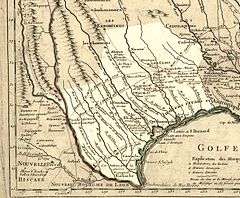
In 1690 Spanish authorities, concerned that France posed a competitive threat, constructed several missions in East Texas.[71] After Native American resistance, the Spanish missionaries returned to Mexico.[72] When France began settling Louisiana, mostly in the southern part of the state, in 1716 Spanish authorities responded by founding a new series of missions in East Texas.[73] Two years later, they created San Antonio as the first Spanish civilian settlement in the area.[74]
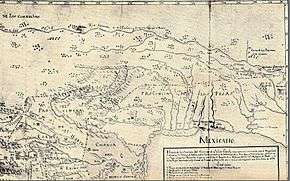
Hostile native tribes and distance from nearby Spanish colonies discouraged settlers from moving to the area. It was one of New Spain's least populated provinces.[76] In 1749, the Spanish peace treaty with the Lipan Apache[77] angered many tribes, including the Comanche, Tonkawa, and Hasinai.[78] The Comanche signed a treaty with Spain in 1785[79] and later helped to defeat the Lipan Apache and Karankawa tribes.[80] With more numerous missions being established, priests led a peaceful conversion of most tribes. By the end of the 18th century only a few nomadic tribes had not converted to Christianity.[81]
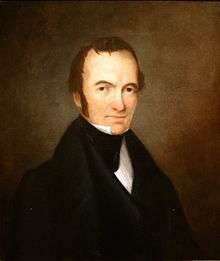
.png)
When the United States purchased Louisiana from France in 1803, American authorities insisted the agreement also included Texas. The boundary between New Spain and the United States was finally set at the Sabine River in 1819, at what is now the border between Texas and Louisiana.[82] Eager for new land, many United States settlers refused to recognize the agreement. Several filibusters raised armies to invade the area west of the Sabine River.[83] In 1821, the Mexican War of Independence included the Texas territory, which became part of Mexico.[84] Due to its low population, Mexico made the area part of the state of Coahuila y Tejas.[85]
Hoping more settlers would reduce the near-constant Comanche raids, Mexican Texas liberalized its immigration policies to permit immigrants from outside Mexico and Spain.[86] Under the Mexican immigration system, large swathes of land were allotted to empresarios, who recruited settlers from the United States, Europe, and the Mexican interior. The first grant, to Moses Austin, was passed to his son Stephen F. Austin after his death.
Austin's settlers, the Old Three Hundred, made places along the Brazos River in 1822.[87] Twenty-three other empresarios brought settlers to the state, the majority of whom were from the United States.[88] The population of Texas grew rapidly. In 1825, Texas had about 3,500 people, with most of Mexican descent.[89] By 1834, the population had grown to about 37,800 people, with only 7,800 of Mexican descent.[90] Most of these early settlers who arrived with Austin and soon after were persons less than fortunate in life, as Texas was devoid of the comforts found elsewhere in Mexico and the United States during that time. Early Texas settler David B. Edwards described his fellow Texans as being "banished from the pleasures of life".[91]
Many immigrants openly flouted Mexican law, especially the prohibition against slavery. Combined with United States' attempts to purchase Texas, Mexican authorities decided in 1830 to prohibit continued immigration from the United States.[92] Illegal immigration from the United States into Mexico continued to increase the population of Texas anyway.[93] New laws also called for the enforcement of customs duties angering native Mexican citizens (Tejanos) and recent immigrants alike.[94]
The Anahuac Disturbances in 1832 were the first open revolt against Mexican rule, and they coincided with a revolt in Mexico against the nation's president.[95] Texians sided with the federalists against the current government and drove all Mexican soldiers out of East Texas.[96] They took advantage of the lack of oversight to agitate for more political freedom. Texians met at the Convention of 1832 to discuss requesting independent statehood, among other issues.[97] The following year, Texians reiterated their demands at the Convention of 1833.[98]
Republic
Within Mexico, tensions continued between federalists and centralists. In early 1835, wary Texians formed Committees of Correspondence and Safety.[99] The unrest erupted into armed conflict in late 1835 at the Battle of Gonzales.[100] This launched the Texas Revolution, and over the next two months the Texians defeated all Mexican troops in the region.[101] Texians elected delegates to the Consultation, which created a provisional government.[102] The provisional government soon collapsed from infighting, and Texas was without clear governance for the first two months of 1836.[103]
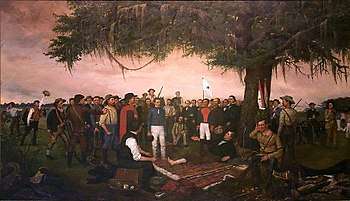
During this time of political turmoil, Mexican President Antonio López de Santa Anna personally led an army to end the revolt.[104] The Mexican expedition was initially successful. General José de Urrea defeated all the Texian resistance along the coast culminating in the Goliad massacre.[105] Santa Anna's forces, after a thirteen-day siege, overwhelmed Texian defenders at the Battle of the Alamo. News of the defeats sparked panic among Texas settlers.[106]
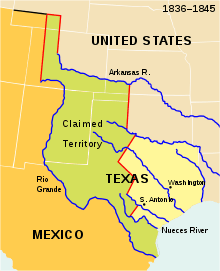
The newly elected Texian delegates to the Convention of 1836 quickly signed a Declaration of Independence on March 2, forming the Republic of Texas. After electing interim officers, the Convention disbanded.[107] The new government joined the other settlers in Texas in the Runaway Scrape, fleeing from the approaching Mexican army.[106] After several weeks of retreat, the Texian Army commanded by Sam Houston attacked and defeated Santa Anna's forces at the Battle of San Jacinto.[108] Santa Anna was captured and forced to sign the Treaties of Velasco, ending the war.[109] The Constitution of the Republic of Texas prohibited the government from restricting slavery or freeing slaves, required free people of African descent to leave the country, and prohibited Native Americans from becoming citizens.
While Texas had won its independence, political battles raged between two factions of the new Republic. The nationalist faction, led by Mirabeau B. Lamar, advocated the continued independence of Texas, the expulsion of the Native Americans, and the expansion of the Republic to the Pacific Ocean. Their opponents, led by Sam Houston, advocated the annexation of Texas to the United States and peaceful co-existence with Native Americans. The conflict between the factions was typified by an incident known as the Texas Archive War.[110] With wide popular support, Texas first applied for annexation to the United States in 1836, but its status as a slaveholding country caused its admission to be controversial and it was initially rebuffed. This status, and Mexican diplomacy in support of its claims to the territory, also complicated Texas's ability to form foreign alliances and trade relationships.[111]
Mexico launched two small expeditions into Texas in 1842. The town of San Antonio was captured twice and Texans were defeated in battle in the Dawson massacre. Despite these successes, Mexico did not keep an occupying force in Texas, and the republic survived.[112] The cotton price crash of the 1840s depressed the country's economy,[111] contributing to the republic's inability to defend itself, and adding momentum to Texas's eventual annexation into the United States.
Statehood
As early as 1837, the Republic made several attempts to negotiate annexation with the United States.[113] Opposition within the republic from the nationalist faction, along with strong abolitionist opposition within the United States, slowed Texas's admission into the Union. Texas was finally annexed when the expansionist James K. Polk won the election of 1844.[114] On December 29, 1845, Congress admitted Texas to the U.S. as a constituent state of the Union.[115]
The population of the new state was quite small at first, and there was a strong mix between the English-speaking American settlers who dominated in the state's eastern/northeastern portions and the Spanish-speaking former Mexicans who dominated in the state's southern and western portions. Statehood brought many new settlers. Because of the long Spanish presence in Mexico and various failed colonization efforts by the Spanish and Mexicans in northern Mexico, there were large herds of Longhorn cattle that roamed the state. Hardy by nature, but also suitable for slaughtering and consumption, they represented an economic opportunity many entrepreneurs seized upon, thus creating the cowboy culture for which Texas is famous. While in the early days of the republic cattle and bison were slaughtered for their hides, soon a beef industry was established with cattle being shipped all over the U.S. and the Caribbean (within a few decades, beef had become a staple of the American diet).
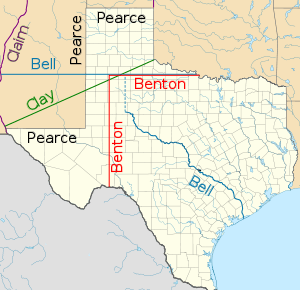
After Texas's annexation, Mexico broke diplomatic relations with the United States. While the United States claimed Texas's border stretched to the Rio Grande, Mexico claimed it was the Nueces River leaving the Rio Grande Valley under contested Texan sovereignty.[115] While the former Republic of Texas could not enforce its border claims, the United States had the military strength and the political will to do so. President Polk ordered General Zachary Taylor south to the Rio Grande on January 13, 1846. A few months later Mexican troops routed an American cavalry patrol in the disputed area in the Thornton Affair starting the Mexican–American War. The first battles of the war were fought in Texas: the Siege of Fort Texas, Battle of Palo Alto and Battle of Resaca de la Palma. After these decisive victories, the United States invaded Mexican territory, ending the fighting in Texas.[116]
After a series of United States victories, the Treaty of Guadalupe Hidalgo ended the two-year war. In return, for US$18,250,000, Mexico gave the U.S. undisputed control of Texas, ceded the Mexican Cession in 1848, most of which today is called the American Southwest, and Texas's borders were established at the Rio Grande.[116]
The Compromise of 1850 set Texas's boundaries at their present form. U.S. Senator James Pearce of Maryland drafted the final proposal[27] where Texas ceded its claims to land which later became half of present-day New Mexico, a third of Colorado, and small portions of Kansas, Oklahoma, and Wyoming to the federal government, in return for the assumption of $10 million of the old republic's debt.[27] Post-war Texas grew rapidly as migrants poured into the cotton lands of the state.[117]
They also brought or purchased enslaved African Americans, whose numbers tripled in the state from 1850 to 1860, from 58,000 to 182,566.[118]
Civil War and Reconstruction (1860–1900)
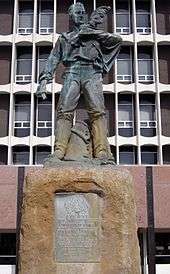
Texas was at war again after the election of 1860. At this time, blacks comprised 30 percent of the state's population, and they were overwhelmingly enslaved.[119] When Abraham Lincoln was elected, South Carolina seceded from the Union. Five other Lower South states quickly followed. A State Convention considering secession opened in Austin on January 28, 1861. On February 1, by a vote of 166–8, the Convention adopted an Ordinance of Secession from the United States. Texas voters approved this Ordinance on February 23, 1861. Texas joined the newly created Confederate States of America on March 4, 1861 ratifying the permanent C.S. Constitution on March 23.[1][120]
Not all Texans favored secession initially, although many of the same would later support the Southern cause. Texas's most notable Unionist was the state Governor, Sam Houston. Not wanting to aggravate the situation, Houston refused two offers from President Lincoln for Union troops to keep him in office. After refusing to swear an oath of allegiance to the Confederacy, Houston was deposed as governor.[121]
While far from the major battlefields of the American Civil War, Texas contributed large numbers of men and equipment to the rest of the Confederacy.[122] Union troops briefly occupied the state's primary port, Galveston. Texas's border with Mexico was known as the "backdoor of the Confederacy" because trade occurred at the border, bypassing the Union blockade.[123] The Confederacy repulsed all Union attempts to shut down this route,[122] but Texas's role as a supply state was marginalized in mid-1863 after the Union capture of the Mississippi River. The final battle of the Civil War was fought near Brownsville, Texas at Palmito Ranch[124] with a Confederate victory.
Texas descended into anarchy for two months between the surrender of the Army of Northern Virginia and the assumption of authority by Union General Gordon Granger. Violence marked the early months of Reconstruction.[122] Juneteenth commemorates the announcement of the Emancipation Proclamation in Galveston by General Gordon Granger, almost two and a half years after the original announcement.[125][126] President Johnson, in 1866, declared the civilian government restored in Texas.[127] Despite not meeting reconstruction requirements, Congress resumed allowing elected Texas representatives into the federal government in 1870. Social volatility continued as the state struggled with agricultural depression and labor issues.[128]
Like most of the South, the Texas economy was devastated by the War. However, since the state had not been as dependent on slaves as other parts of the South, it was able to recover more quickly. The culture in Texas during the later 19th century exhibited many facets of a frontier territory. The state became notorious as a haven for people from other parts of the country who wanted to escape debt, criminal prosecution, or other problems. Indeed, "Gone to Texas" was a common expression for those fleeing the law in other states. Nevertheless, the state also attracted many businessmen and other settlers with more legitimate interests as well.
The cattle industry continued to thrive, though it gradually became less profitable. Cotton and lumber became major industries creating new economic booms in various regions of the state. Railroad networks grew rapidly as did the port at Galveston as commerce between Texas and the rest of the U.S. (and the rest of the world) expanded. As with some other states before, the lumber industry quickly decimated the forests of Texas such that, by the early 20th century, the majority of the forest population in Texas was gone (later conservation efforts restored some of it, but never to the level it once was).
Earlier 20th century

In 1900, Texas suffered the deadliest natural disaster in U.S. history during the Galveston hurricane.[47] On January 10, 1901, the first major oil well in Texas, Spindletop, was found south of Beaumont. Other fields were later discovered nearby in East Texas, West Texas, and under the Gulf of Mexico. The resulting "oil boom" transformed Texas.[129] Oil production eventually averaged three million barrels per day at its peak in 1972.[130]
In 1901, the Democratic-dominated state legislature passed a bill requiring payment of a poll tax for voting, which effectively disenfranchised most blacks and many poor whites and Latinos. In addition, the legislature established white primaries, ensuring minorities were excluded from the formal political process. The number of voters dropped dramatically, and the Democrats crushed competition from the Republican and Populist parties.[131][132] The Socialist Party became the second-largest party in Texas after 1912,[133] coinciding with a large socialist upsurge in the United States during fierce battles in the labor movement and the popularity of national heroes like Eugene V. Debs. The Socialists' popularity soon waned after their vilification by the United States government for their opposition to US involvement in World War I.
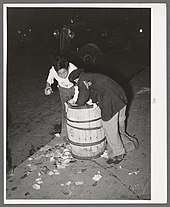
The Great Depression and the Dust Bowl dealt a double blow to the state's economy, which had significantly improved since the Civil War. Migrants abandoned the worst-hit sections of Texas during the Dust Bowl years. Especially from this period on, blacks left Texas in the Great Migration to get work in the Northern United States or California and to escape the oppression of segregation.[119] In 1940, Texas was 74 percent Anglo, 14.4 percent black, and 11.5 percent Hispanic.[134]
World War II had a dramatic impact on Texas, as federal money poured in to build military bases, munitions factories, POW detention camps and Army hospitals; 750,000 young men left for service; the cities exploded with new industry; the colleges took on new roles; and hundreds of thousands of poor farmers left the fields for much better-paying war jobs, never to return to agriculture.[135][136] Texas manufactured 3.1 percent of total United States military armaments produced during World War II, ranking eleventh among the 48 states.[137]
Texas modernized and expanded its system of higher education through the 1960s. The state created a comprehensive plan for higher education, funded in large part by oil revenues, and a central state apparatus designed to manage state institutions more efficiently. These changes helped Texas universities receive federal research funds.[138]
On November 22, 1963, President John F. Kennedy was assassinated in Dallas.[139]
Economic and political change (1950–present)
Beginning around the mid-20th century, Texas began to transform from a rural and agricultural state to one urban and industrialized.[140] The state's population grew quickly during this period, with large levels of migration from outside the state.[140] As a part of the Sun Belt, Texas experienced strong economic growth, particularly during the 1970s and early 1980s.[140] Texas's economy diversified, lessening its reliance on the petroleum industry.[140] By 1990, Hispanics overtook blacks to become the largest minority group in the state.[140]
During the late 20th century, the Republican Party replaced the Democratic Party as the dominant party in the state, as the latter became more politically liberal and as demographic changes favored the former.[140]
Government and politics
The current Texas Constitution was adopted in 1876. Like many states, it explicitly provides for a separation of powers. The state's Bill of Rights is much larger than its federal counterpart, and has provisions unique to Texas.[141]
State government
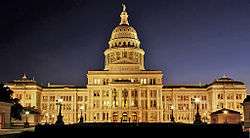
Texas has a plural executive branch system limiting the power of the governor, which is a weak executive compared to some other states. Except for the Secretary of State, voters elect executive officers independently; thus candidates are directly answerable to the public, not the governor.[142] This election system has led to some executive branches split between parties and reduced the ability of the governor to carry out a program. When Republican President George W. Bush served as Texas's governor, the state had a Democratic lieutenant governor, Bob Bullock. The executive branch positions consist of the Governor, Lieutenant Governor, Comptroller of Public Accounts, Land Commissioner, Attorney General, Agriculture Commissioner, the three-member Texas Railroad Commission, the State Board of Education, and the Secretary of State.[142]
The bicameral Texas Legislature consists of the House of Representatives, with 150 members, and a Senate, with 31 members. The Speaker of the House leads the House, and the lieutenant governor, the Senate.[143] The Legislature meets in regular session biennially for just over a hundred days, but the governor can call for special sessions as often as desired (notably, the Legislature cannot call itself into session).[144] The state's fiscal year begins September 1.
The judiciary of Texas is one of the most complex in the United States, with many layers and overlapping jurisdictions. Texas has two courts of last resort: the Texas Supreme Court, for civil cases, and the Texas Court of Criminal Appeals. Except for some municipal benches, partisan elections select judges at all levels of the judiciary; the governor fills vacancies by appointment.[145] Texas is notable for its use of capital punishment, having led the country in executions since capital punishment was reinstated in the Gregg v. Georgia case (see Capital punishment in Texas).
The Texas Ranger Division of the Texas Department of Public Safety is a law enforcement agency with statewide jurisdiction. Over the years, the Texas Rangers have investigated crimes ranging from murder to political corruption. They have acted as riot police and as detectives, protected the Texas governor, tracked down fugitives, and functioned as a paramilitary force both for the republic and for the state. The Texas Rangers were unofficially created by Stephen F. Austin in 1823 and formally constituted in 1835. The Rangers were integral to several important events of Texas history and some of the best-known criminal cases in the history of the Old West.[146]
The Texas constitution defines the responsibilities of county governments, which serve as agents of the state. What are called commissioners court and court judges are elected to serve as the administrative arm. Most cities in the state, those over 5,000 in population, have home-rule governments. The vast majority of these have charters for council-manager forms of government, by which voters elect council members, who hire a professional city manager as an operating officer.
Politics
Political history

In the 1870s, white Democrats wrested power back in the state legislature from the biracial coalition at the end of Reconstruction. In the early 20th century, the legislature passed bills to impose poll taxes, followed by white primaries; these measures effectively disfranchised most blacks, poor whites and Mexican Americans.[131][132] In the 1890s, 100,000 blacks voted in the state; by 1906, only 5,000 could vote.[147] As a result, the Democratic Party dominated Texas politics from the turn of the century, imposing racial segregation and white supremacy. It held power until after passage in the mid-1960s of national civil rights legislation enforcing constitutional rights of all citizens.
Although Texas was essentially a one-party state during this time and the Democratic primary was viewed as "the real election", the Democratic Party had conservative and liberal factions, which became more pronounced after the New Deal.[148] Additionally, several factions of the party briefly split during the 1930s and 1940s.[148]
The state's conservative white voters began to support Republican presidential candidates by the mid-20th century. After this period, they supported Republicans for local and state offices as well, and most whites became Republican Party members.[149] The party also attracted some minorities, but many have continued to vote for Democratic candidates. The shift to the Republican Party is much-attributed to the fact the Democratic Party became increasingly liberal during the 20th century, and thus increasingly out-of-touch with the average Texas voter.[150] As Texas was always a conservative state, voters switched to the GOP, which now more closely reflected their beliefs.[150][151] Commentators have also attributed the shift to Republican political consultant Karl Rove, who managed numerous political campaigns in Texas in the 1980s and 1990s.[151] Other stated reasons included court-ordered redistricting and the demographic shift in relation to the Sun Belt that favored the Republican Party and conservatism.[140]
The 2003 Texas redistricting of Congressional districts led by Republican Tom DeLay, was called by The New York Times "an extreme case of partisan gerrymandering".[152] A group of Democratic legislators, the "Texas Eleven", fled the state in a quorum-busting effort to prevent the legislature from acting, but was unsuccessful.[153] The state had already redistricted following the 2000 census. Despite these efforts, the legislature passed a map heavily in favor of Republicans, based on 2000 data and ignoring the estimated nearly one million new residents in the state since then. Career attorneys and analysts at the Department of Justice objected to the plan as diluting the votes of African American and Hispanic voters, but political appointees overrode them and approved it.[152] Legal challenges to the redistricting reached the national Supreme Court in the case League of United Latin American Citizens v. Perry (2006), but the court ruled in favor of the state (and Republicans).[154]
In the 2014 Texas elections, the Tea Party movement made large gains, with numerous Tea Party favorites being elected into office, including Dan Patrick as lieutenant governor,[155][156] Ken Paxton as attorney general,[155][157] in addition to numerous other candidates[157] including conservative Republican Greg Abbott as governor.[158]
Texas politics today
Texas voters lean toward fiscal conservatism, while enjoying the benefits of huge federal investment in the state in military and other facilities achieved by the power of the Solid South in the 20th century. They also tend to have socially conservative values.[159][160]
Since 1980, most Texas voters have supported Republican presidential candidates. In 2000 and 2004, Republican George W. Bush won Texas with respectively 59.3 and 60.1 percent of the vote, partly due to his "favorite son" status as a former governor of the state. John McCain won the state in 2008, but with a smaller margin of victory compared to Bush at 55 percent of the vote. Austin, Dallas, Houston, and San Antonio consistently lean Democratic in both local and statewide elections.
The state's changing demographics may result in a change in its overall political alignment, as a majority population of Black and Hispanic/Latino voters support the Democratic Party.[161] Residents of counties along the Rio Grande closer to the Mexico–United States border, where there are many Latino residents, generally vote for Democratic Party candidates, while most other rural and suburban areas of Texas have shifted to voting for Republican Party candidates.[162][163]
As of the general elections of 2014, a large majority of the members of Texas's U.S. House delegation are Republican, along with both U.S. Senators. In the 114th United States Congress, of the 36 Congressional districts in Texas, 24 are held by Republicans and 11 by Democrats. One seat is vacant. Texas's Senators are John Cornyn and Ted Cruz. Since 1994, Texans have not elected a Democrat to a statewide office. The state's Democratic voters are made up primarily by liberal and minority groups in Austin, Beaumont, Dallas, El Paso, Houston, and San Antonio as well as minority voters in East and South Texas.
Texas has banned sanctuary cities,[164] but Houston Mayor Sylvester Turner has vowed that the city will not assist ICE agents.[165]
| United States presidential election in Texas, 2016[166] | ||||||
|---|---|---|---|---|---|---|
| Party | Candidate | Running mate | Votes | Percentage | Electoral votes | |
| Republican | Donald Trump | Mike Pence | 4,685,047 | 52.23% | 36 | |
| Democratic | Hillary Clinton | Tim Kaine | 3,877,868 | 43.24% | 0 | |
| Libertarian | Gary Johnson | William Weld | 283,492 | 3.16% | 0 | |
| Green | Jill Stein | Ajamu Baraka | 71,558 | 0.80% | 0 | |
| Write-in | Various candidates | Various candidates | 51,261 | 0.57% | 0 | |
| Totals | 8,969,226 | 100.00% | 38 | |||
| Voter turnout (voting age population) | ||||||
Administrative divisions
Texas has 254 counties—the most nationwide. Each county runs on Commissioners' Court system consisting of four elected commissioners (one from each of four precincts in the county, roughly divided according to population) and a county judge elected at large from the entire county. County government runs similar to a "weak" mayor-council system; the county judge has no veto authority, but votes along with the other commissioners.
Although Texas permits cities and counties to enter "interlocal agreements" to share services, the state does not allow consolidated city-county governments, nor does it have metropolitan governments. Counties are not granted home rule status; their powers are strictly defined by state law. The state does not have townships—areas within a county are either incorporated or unincorporated. Incorporated areas are part of a municipality. The county provides limited services to unincorporated areas and to some smaller incorporated areas. Municipalities are classified either "general law" cities or "home rule".[167] A municipality may elect home rule status once it exceeds 5,000 population with voter approval.
Texas also permits the creation of "special districts", which provide limited services. The most common is the school district, but can also include hospital districts, community college districts, and utility districts (one utility district near Austin was the plaintiff in a landmark Supreme Court case involving the Voting Rights Act).
Municipal, school district, and special district elections are nonpartisan,[168] though the party affiliation of a candidate may be well-known. County and state elections are partisan.
Criminal law
Texas has a reputation of very harsh criminal punishment for criminal offenses. It is one of the 32 states that practice capital punishment, and since the US Supreme Court allowed capital punishment to resume in 1976, 40% of all US executions have taken place in Texas.[169] As of 2008, Texas had the 4th highest incarceration rate in the US.[170] Texas also has strong self defense laws, allowing citizens to use lethal force to defend themselves, their families, or their property.[171]
Economy

As of 2019, Texas had a gross state product (GSP) of $1.9 trillion, the second highest in the U.S.[172] Its GSP is greater than the GDPs of Brazil, Canada, Russia, South Korea and Spain, which are the world's 9th-, 10th-, 11th-, 12th- and 13th-largest economies, respectively.[173] Texas's economy is the second-largest of any country subdivision globally, behind California. Its per capita personal income in 2009 was $36,484, ranking 29th in the nation.[174]
.png)
Texas's large population, an abundance of natural resources, thriving cities and leading centers of higher education have contributed to a large and diverse economy. Since oil was discovered, the state's economy has reflected the state of the petroleum industry. In recent times, urban centers of the state have increased in size, containing two-thirds of the population in 2005. The state's economic growth has led to urban sprawl and its associated symptoms.[174]
As of May 2020, during the COVID-19 pandemic, the state's unemployment rate was 13 percent.[175]
In 2010, Site Selection Magazine ranked Texas as the most business-friendly state in the nation, in part because of the state's three-billion-dollar Texas Enterprise Fund.[176] Texas has the joint-highest number of Fortune 500 company headquarters in the United States, along with California.[177][178]
In 2010, there were 346,000 millionaires in Texas, constituting the second-largest population of millionaires in the nation.[179][180]
Taxation
Texas has a "low taxes, low services" reputation.[159] According to the Tax Foundation, Texans' state and local tax burdens rank among the lowest in the nation, 7th lowest nationally; state and local taxes cost $3,580 per capita, or 8.4 percent of resident incomes.[181] Texas is one of seven states that lack a state income tax.[181][182]
Instead, the state collects revenue from property taxes (though these are collected at the county, city, and school district level; Texas has a state constitutional prohibition against a state property tax) and sales taxes. The state sales tax rate is 6.25 percent,[181][183] but local taxing jurisdictions (cities, counties, special purpose districts, and transit authorities) may also impose sales and use tax up to 2 percent for a total maximum combined rate of 8.25 percent.[184]
Texas is a "tax donor state"; in 2005, for every dollar Texans paid to the federal government in federal income taxes, the state got back about $0.94 in benefits.[181] To attract business, Texas has incentive programs worth $19 billion per year (2012); more than any other US state.[185][186]
Agriculture and mining
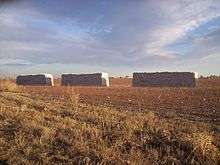

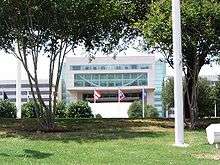
Texas has the most farms and the highest acreage in the United States. The state is ranked No. 1 for revenue generated from total livestock and livestock products. It is ranked No. 2 for total agricultural revenue, behind California.[187] At $7.4 billion or 56.7 percent of Texas's annual agricultural cash receipts, beef cattle production represents the largest single segment of Texas agriculture. This is followed by cotton at $1.9 billion (14.6 percent), greenhouse/nursery at $1.5 billion (11.4 percent), broilers at $1.3 billion (10 percent), and dairy products at $947 million (7.3 percent).[188]
Texas leads the nation in the production of cattle, horses, sheep, goats, wool, mohair and hay.[188] The state also leads the nation in production of cotton[187][189] which is the number one crop grown in the state in terms of value.[190] The state grows significant amounts of cereal crops and produce.[187] Texas has a large commercial fishing industry. With mineral resources, Texas leads in creating cement, crushed stone, lime, salt, sand and gravel.[187]
Texas throughout the 21st century has been hammered by drought. This has cost the state billions of dollars in livestock and crops.[191]
Energy
Ever since the discovery of oil at Spindletop, energy has been a dominant force politically and economically within the state.[192] If Texas were its own country it would be the sixth largest oil producer in the world.[193]
The Railroad Commission of Texas, contrary to its name, regulates the state's oil and gas industry, gas utilities, pipeline safety, safety in the liquefied petroleum gas industry, and surface coal and uranium mining. Until the 1970s, the commission controlled the price of petroleum because of its ability to regulate Texas's oil reserves. The founders of the Organization of Petroleum Exporting Countries (OPEC) used the Texas agency as one of their models for petroleum price control.[194]
Texas has known petroleum deposits of about 5 billion barrels (790,000,000 m3), which makes up about one-fourth of the known U.S. reserves.[195] The state's refineries can process 4.6 million barrels (730,000 m3) of oil a day.[195] The Port Arthur Refinery in Southeast Texas is the largest refinery in the U.S.[195] Texas also leads in natural gas production, producing one-fourth of the nation's supply.[195] Several petroleum companies are based in Texas such as: Occidental Petroleum, ConocoPhillips, ExxonMobil, Halliburton, Marathon Oil, Tesoro, Valero Energy, and Western Refining.
According to the Energy Information Administration, Texans consume, on average, the fifth most energy (of all types) in the nation per capita and as a whole, following behind Wyoming, Alaska, Louisiana, North Dakota, and Iowa.[195]
Unlike the rest of the nation, most of Texas is on its own alternating current power grid, the Texas Interconnection. Texas has a deregulated electric service. Texas leads the nation in total net electricity production, generating 437,236 MWh in 2014, 89% more MWh than Florida, which ranked second.[196][197] As an independent nation, Texas would rank as the world's eleventh-largest producer of electricity, after South Korea, and ahead of the United Kingdom.
The state is a leader in renewable energy commercialization; it produces the most wind power in the nation.[195][198] In 2014, 10.6% of the electricity consumed in Texas came from wind turbines.[199] The Roscoe Wind Farm in Roscoe, Texas, is one of the world's largest wind farms with a 781.5 megawatt (MW) capacity.[200] The Energy Information Administration states the state's large agriculture and forestry industries could give Texas an enormous amount biomass for use in biofuels. The state also has the highest solar power potential for development in the nation.[195]
Technology
With large universities systems coupled with initiatives like the Texas Enterprise Fund and the Texas Emerging Technology Fund, a wide array of different high tech industries have developed in Texas. The Austin area is nicknamed the "Silicon Hills" and the north Dallas area the "Silicon Prairie". Many high-tech companies are located in or have their headquarters in Texas (and Austin in particular), including Dell, Inc., Borland, Forcepoint, Indeed.com, Texas Instruments, Perot Systems, Rackspace and AT&T.
The National Aeronautics and Space Administration's Lyndon B. Johnson Space Center (NASA JSC) in Southeast Houston, sits as the crown jewel of Texas's aeronautics industry. Fort Worth hosts both Lockheed Martin's Aeronautics division and Bell Helicopter Textron.[201][202] Lockheed builds the F-16 Fighting Falcon, the largest Western fighter program, and its successor, the F-35 Lightning II in Fort Worth.[203]
Commerce
Texas's affluence stimulates a strong commercial sector consisting of retail, wholesale, banking and insurance, and construction industries. Examples of Fortune 500 companies not based on Texas traditional industries are AT&T, Kimberly-Clark, Blockbuster, J. C. Penney, Whole Foods Market, and Tenet Healthcare.[204] Nationally, the Dallas–Fort Worth area, home to the second shopping mall in the United States, has the most shopping malls per capita of any American metropolitan area.[205]
Mexico, the state's largest trading partner, imports a third of the state's exports because of the North American Free Trade Agreement (NAFTA). NAFTA has encouraged the formation of controversial maquiladoras on the Texas–Mexico border.[206]
Demographics
| Historical population | |||
|---|---|---|---|
| Census | Pop. | %± | |
| 1850 | 212,592 | — | |
| 1860 | 604,215 | 184.2% | |
| 1870 | 818,579 | 35.5% | |
| 1880 | 1,591,749 | 94.5% | |
| 1890 | 2,235,527 | 40.4% | |
| 1900 | 3,048,710 | 36.4% | |
| 1910 | 3,896,542 | 27.8% | |
| 1920 | 4,663,228 | 19.7% | |
| 1930 | 5,824,715 | 24.9% | |
| 1940 | 6,414,824 | 10.1% | |
| 1950 | 7,711,194 | 20.2% | |
| 1960 | 9,579,677 | 24.2% | |
| 1970 | 11,196,730 | 16.9% | |
| 1980 | 14,229,191 | 27.1% | |
| 1990 | 16,986,510 | 19.4% | |
| 2000 | 20,851,820 | 22.8% | |
| 2010 | 25,145,561 | 20.6% | |
| Est. 2019 | 28,995,881 | 15.3% | |
| 1910—2010 census[207] 2019 Estimate[208] | |||
The United States Census Bureau estimates the population of Texas was 28,995,881 on July 1, 2019, a 15.31 percent increase since the 2010 United States Census.[208][6]

As of 2015, Texas had 4.7 million foreign-born residents, about 17% of the population and 21.6% of the state workforce.[209] The major countries of origin for Texan immigrants were Mexico (55.1% of immigrants), India (5%), El Salvador (4.3%), Vietnam (3.7%), and China (2.3%).[209] Of immigrant residents, some 35.8 percent were naturalized U.S. citizens.[209] In 2014, there were an estimated 1.7 million undocumented immigrants in Texas, making up 35% of the total Texas immigrant population and 6.1% of the total state population.[209] In addition to the state's foreign-born population, an additional 4.1 million Texans (15% of the state's population) were born in the United States and had at least one immigrant parent.[209]
Texas's Rio Grande Valley has seen significant migration from across the U.S.–Mexico border. During the 2014 crisis, many Central Americans, including unaccompanied minors traveling alone from Guatemala, Honduras, and El Salvador, reached the state, overwhelming Border Patrol resources for a time. Many sought asylum in the United States.[210][211]
Texas's population density is 90.5 people per square mile (34.9/km2) which is slightly higher than the average population density of the U.S. as a whole, at 80.6 people per square mile (31.1/km2). In contrast, while Texas and France are similarly sized geographically, the European country has a population density of 301.8 people per square mile (116.5/km2).
Two-thirds of all Texans live in major metropolitan areas such as Houston. The Dallas-Fort Worth Metropolitan Area is the largest in Texas. While Houston is the largest city in Texas and the fourth-largest city in the United States, the Dallas-Fort Worth metropolitan area is larger than Houston.
Ethnicity
As of the 2015 Texas Population Estimate Program, the population of the state was 27,469,114; non-Hispanic whites 11,505,371 (41.9%); Black Americans 3,171,043 (11.5%); other races 1,793,580 (6.5%); and Hispanics and Latinos (of any race) 10,999,120 (40.0%).[212]
According to the 2010 United States census, the racial composition of Texas was the following:[213]
- White American 70.4 percent (Non-Hispanic whites 45.3 percent)
- Black or African American: 11.8 percent
- American Indian: 0.7 percent
- Asian: 3.8 percent (1.0 percent Indian, 0.8 percent Vietnamese, 0.6 percent Chinese, 0.4 percent Filipino, 0.3 percent Korean, 0.1 percent Japanese, 0.6 percent other Asian)
- Pacific Islander: 0.1 percent
- Some other race: 10.5 percent
- Two or more races: 2.7 percent
In addition, 37.6 percent of the population was Hispanic or Latino (of any race) (31.6 percent Mexican, 0.9 percent Salvadoran, 0.5 percent Puerto Rican, 0.4 percent Honduran, 0.3 percent Guatemalan 0.3 percent Spaniard, 0.2 percent Colombian, 0.2 percent Cuban).[214]
As of 2011, 69.8% of the population of Texas younger than age 1 were minorities (meaning they had at least one parent who was not non-Hispanic white).[215]
| Racial composition | 1970[216] | 1990[216] | 2000[217] | 2010[218] |
|---|---|---|---|---|
| White | 86.8% | 75.2% | 71.0% | 70.4% |
| Black | 12.5% | 11.9% | 11.5% | 11.9% |
| Asian | 0.2% | 1.9% | 2.7% | 3.8% |
| Native | 0.2% | 0.4% | 0.6% | 0.7% |
| Native Hawaiian and other Pacific Islander | – | – | 0.1% | 0.1% |
| Other race | 0.4% | 10.6% | 11.7% | 10.5% |
| Two or more races | – | – | 2.5% | 2.7% |

German, Irish, and English Americans are the three largest European ancestry groups in Texas. German Americans make up 11.3 percent of the population and number over 2.7 million members. Irish Americans make up 8.2 percent of the population and number over 1.9 million. There are roughly 600,000 French Americans and 472,000 Italian Americans residing in Texas; these two ethnic groups make up 2.5 percent and 2.0 percent of the population respectively. In the 1980 United States Census the largest ancestry group reported in Texas was English with 3,083,323 Texans citing they were of English or mostly English ancestry, making them 27 percent of the state at the time.[219] Their ancestry primarily goes back to the original thirteen colonies (the census of 1790 gives 48% of the population of English ancestry, together with 12% Scots and Scots-Irish, 4.5% other Irish, and 3% Welsh, for a total of 67.5% British and Irish; 13% were German, Swiss, Dutch, and French Huguenots; 19% were African-American),[220] thus many of them today identify as "American" in ancestry, though they are of predominantly British stock.[221][222] There are nearly 200,000 Czech Americans living in Texas, the largest number of any state.[223]
African Americans are the largest racial minority in Texas. Their proportion of the population has declined since the early 20th century after many left the state in the Great Migration. Blacks of both Hispanic and non-Hispanic origin make up 11.5 percent of the population; blacks of non-Hispanic origin form 11.3 percent of the populace. African Americans of both Hispanic and non-Hispanic origin number at roughly 2.7 million individuals.
Native Americans are a smaller minority in the state. Native Americans make up 0.5 percent of Texas's population and number over 118,000 individuals. Native Americans of non-Hispanic origin make up 0.3 percent of the population and number over 75,000 individuals. Cherokee made up 0.1 percent of the population, and numbered over 19,400. In contrast, only 583 identified as Chippewa.
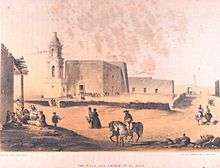
Asian Americans are a sizable minority group in Texas. Americans of Asian descent form 3.8 percent of the population, with those of non-Hispanic descent making up 3.7 percent of the populace. They total more than 808,000 individuals. Non-Hispanic Asians number over 795,000. Just over 200,000 Indian Americans make Texas their home. Texas is also home to more than 187,000 Vietnamese and 136,000 Chinese. In addition to 92,000 Filipinos and 62,000 Koreans, there are 18,000 Japanese Americans living in the state. Lastly, more than 111,000 people are of other Asian ancestry groups, such as Cambodian, Thai, and Hmong. Sugar Land, a city within the Houston metropolitan area, and Plano, within the Dallas metropolitan area, both have high concentrations of ethnic Chinese and Korean residents. The Houston and Dallas areas, and to a lesser extent, the Austin metropolitan area, all contain substantial Vietnamese communities.
Americans with origins from the Pacific Islands are the smallest minority in Texas. According to the survey, only 18,000 Texans are Pacific Islanders; 16,400 are of non-Hispanic descent. There are roughly 5,400 Native Hawaiians, 5,300 Guamanians, and 6,400 people from other groups. Samoan Americans were scant; only 2,920 people were from this group. The city of Euless, a suburb of Fort Worth, contains a sizable population of Tongan Americans, at nearly 900 people, over one percent of the city's population. Killeen has a sufficient population of Samoans and Guamanian, and people of Pacific Islander descent surpass one percent of the city's population.
Multiracial individuals are also a visible minority in Texas. People identifying as multiracial form 1.9 percent of the population, and number over 448,000 people. Almost 80,000 Texans claim African and European heritage and makeup 0.3 percent of the population. People of European and American Indian ancestry number over 108,800 (close to the number of Native Americans), and makeup 0.5 percent of the population. People of European and Asian ancestry number over 57,600, and form just 0.2 percent of the population. People of African and Native American ancestry were even smaller in number (15,300), and makeup just 0.1 percent of the total population.

Hispanics and Latinos are the second-largest groups in Texas after non-Hispanic European Americans. More than 8.5 million people claim Hispanic or Latino ethnicity. This group forms over 37 percent of Texas's population. People of Mexican descent alone number over 7.9 million, and make up 31.6 percent of the population. The vast majority of the Hispanic/Latino population in the state is of Mexican descent, the next two largest groups are Salvadorans and Puerto Ricans. There are more than 222,000 Salvadorans and more than 130,000 Puerto Ricans in Texas. Other groups with large numbers in Texas include Hondurans, Guatemalans, Nicaraguans and Cubans, among others.[224][225] The Hispanics in Texas are more likely than in some other states (such as California) to identify as white; according to the 2010 U.S. Census, Texas is home to 6,304,207 White Hispanics and 2,594,206 Hispanics of "some other race" (usually mestizo).
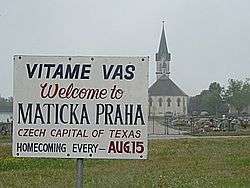
German descendants inhabit much of central and southeast-central Texas. Over one-third of Texas, residents are of Hispanic origin; while many have recently arrived, some Tejanos have ancestors with multi-generational ties to 18th century Texas. The African American population in Texas is increasing due to the New Great Migration.[226][227] In addition to the descendants of the state's former slave population, many African American college graduates have come to the state for work recently in the New Great Migration.[226] Recently, the Asian population in Texas has grown—primarily in Houston and Dallas. Other communities with a significantly growing Asian American population is in Austin, Corpus Christi, San Antonio, and the Sharyland area next McAllen, Texas. Three federally recognized Native American tribes reside in Texas: the Alabama-Coushatta Tribe, the Kickapoo Traditional Tribe, and the Ysleta del Sur Pueblo.[54]
In 2010, 49 percent of all births were Hispanics; 35 percent were non-Hispanic whites; 11.5 percent were non-Hispanic blacks, and 4.3 percent were Asians/Pacific Islanders.[228] Based on Census Bureau data released in February 2011, for the first time in recent history, Texas's white population is below 50 percent (45 percent) and Hispanics grew to 38 percent. Between 2000 and 2010, the total population growth by 20.6 percent, but Hispanics growth by 65 percent, whereas non-Hispanic whites grew by only 4.2 percent.[229] Texas has the fifth highest rate of teenage births in the nation and a plurality of these are to Hispanics.[230]
Cities, towns, and metropolitan areas
| Largest city in Texas by year[231] | |
|---|---|
| Year(s) | City |
| 1850–1870 | San Antonio[232] |
| 1870–1890 | Galveston[233] |
| 1890–1900 | Dallas[231] |
| 1900–1930 | San Antonio[232] |
| 1930–present | Houston[234] |

The state has three cities with populations exceeding one million: Houston, San Antonio, and Dallas.[235] These three rank among the 10 most populous cities of the United States. As of 2010, six Texas cities had populations greater than 600,000 people. Austin, Fort Worth, and El Paso are among the 20 largest U.S. cities. Texas has four metropolitan areas with populations greater than a million: Dallas–Fort Worth–Arlington, Houston–Sugar Land–Baytown, San Antonio–New Braunfels, and Austin–Round Rock–San Marcos. The Dallas–Fort Worth and Houston metropolitan areas number about 6.3 million and 5.7 million residents, respectively.

Three interstate highways—I-35 to the west (Dallas–Fort Worth to San Antonio, with Austin in between), I-45 to the east (Dallas to Houston), and I-10 to the south (San Antonio to Houston) define the Texas Urban Triangle region. The region of 60,000 square miles (160,000 km2) contains most of the state's largest cities and metropolitan areas as well as 17 million people, nearly 75 percent of Texas's total population.[236] Houston and Dallas have been recognized as beta world cities.[237] These cities are spread out amongst the state. Texas has 254 counties, which is more than any other state by 95 (Georgia).[238]
In contrast to the cities, unincorporated rural settlements known as colonias often lack basic infrastructure and are marked by poverty.[239] The office of the Texas Attorney General stated, in 2011, that Texas had about 2,294 colonias and estimates about 500,000 lived in the colonias. Hidalgo County, as of 2011, has the largest number of colonias.[240] Texas has the largest number of people of all states, living in colonias.[239]
Languages
The most common accent or dialect spoken by natives throughout Texas is sometimes referred to as Texan English, which itself is a sub-variety of a broader category of American English known as Southern American English.[242][243] Creole language is spoken in East Texas.[244] In some areas of the state—particularly in the large cities—Western American English and General American English, have been on the increase. Chicano English—due to a growing Hispanic population—is widespread in South Texas, while African-American English is especially notable in historically minority areas of urban Texas.
| Language | Percentage of population (as of 2010)[245] |
|---|---|
| Spanish | 29.21% |
| Vietnamese | 0.75% |
| Chinese (including Mandarin and Cantonese) | 0.56% |
| German | 0.33% |
| Tagalog | 0.29% |
| French | 0.25% |
| Korean and Urdu (tied) | 0.24% |
| Hindi | 0.23% |
| Arabic | 0.21% |
| Niger-Congo languages of West Africa (Ibo, Kru, and Yoruba) | 0.15% |
As of 2010, 65.8% (14,740,304) of Texas residents age 5 and older spoke only English at home, while 29.2% (6,543,702) spoke Spanish, 0.75 percent (168,886) Vietnamese, and Chinese (which includes Cantonese and Mandarin) was spoken by 0.56% (122,921) of the population over five.[245]
Other languages spoken include German (including Texas German) by 0.33% (73,137), Tagalog with 0.29% (64,272) speakers, and French (including Cajun French) was spoken by 0.25% (55,773) of Texans.[245] Reportedly, Cherokee is the most widely spoken Native American language in Texas.[246]
In total, 34.2% (7,660,406) of Texas's population aged five and older spoke a language at home other than English.[245]
Religion
| Affiliation | % of Texas population | |
|---|---|---|
| Christian | 77 | |
| Protestant | 50 | |
| Evangelical Protestant | 31 | |
| Mainline Protestant | 13 | |
| Black church | 6 | |
| Catholic | 23 | |
| Mormon | 1 | |
| Jehovah's Witnesses | 1 | |
| Eastern Orthodox | 0.5 | |
| Other Christian | 1 | |
| Unaffiliated | 18 | |
| Nothing in particular | 13 | |
| Agnostic | 3 | |
| Atheist | 2 | |
| Non-Christian faiths | 4 | |
| Jewish | 1 | |
| Muslim | 1 | |
| Buddhist | 1 | |
| Hindu | 0.5 | |
| Other Non-Christian faiths | 0.5 | |
| Don't know/refused answer | 0.5 | |
| Total | 100 | |
The largest denominations by number of adherents in 2010 were the Roman Catholic Church (4,673,500); the Southern Baptist Convention (3,721,318); Non-denominational Churches (1,546,542); and the United Methodist Church with (1,035,168).[248]
Known as the buckle of the Bible Belt, East Texas is socially conservative.[249] The Dallas–Fort Worth metroplex is home to three major evangelical seminaries and a host of Bible schools. Lakewood Church in Houston, boasts the largest attendance in the nation averaging more than 43,000 weekly.[250]
Adherents of many other religions reside predominantly in the urban centers of Texas. In 1990, the Islamic population was about 140,000 with more recent figures putting the current number of Muslims between 350,000 and 400,000.[251] The Jewish population is around 128,000.[252] Around 146,000 adherents of religions such as Hinduism and Sikhism live in Texas.[253] It is the fifth-largest Muslim-populated state in the country.[254]
Culture

Historically, Texas culture comes from a blend of Southern (Dixie), Western (frontier), and Southwestern (Mexican/Anglo fusion) influences, varying in degrees of such from one intrastate region to another. Texas is placed in the Southern United States by the United States Census Bureau.[255] A popular food item, the breakfast burrito, draws from all three, having a soft flour tortilla wrapped around bacon and scrambled eggs or other hot, cooked fillings. Adding to Texas's traditional culture, established in the 18th and 19th centuries, immigration has made Texas a melting pot of cultures from around the world.
Texas has made a strong mark on national and international pop culture. The entire state is strongly associated with the image of the cowboy shown in westerns and in country western music. The state's numerous oil tycoons are also a popular pop culture topic as seen in the hit TV series Dallas.
The internationally known slogan "Don't Mess with Texas" began as an anti-littering advertisement. Since the campaign's inception in 1986, the phrase has become "an identity statement, a declaration of Texas swagger".[256]
Texas self-perception
"Texas-sized" is an expression that can be used in two ways: to describe something that is about the size of the U.S. state of Texas,[257][258] or to describe something (usually but not always originating from Texas) that is large compared to other objects of its type.[259][260][261] Texas was the largest U.S. state, until Alaska became a state in 1959. The phrase "everything is bigger in Texas" has been in regular use since at least 1950;[262] and was used as early as 1913.[263]
Arts
Houston is one of only five American cities with permanent professional resident companies in all the major performing arts disciplines: the Houston Grand Opera, the Houston Symphony Orchestra, the Houston Ballet, and The Alley Theatre.[264] Known for the vibrancy of its visual and performing arts, the Houston Theater District—a 17-block area in the heart of Downtown Houston—ranks second in the country in the number of theater seats in a concentrated downtown area, with 12,948 seats for live performances and 1,480 movie seats.[264]
Founded in 1892, Modern Art Museum of Fort Worth, also called "The Modern", is Texas's oldest art museum. Fort Worth also has the Kimbell Art Museum, the Amon Carter Museum, the National Cowgirl Museum and Hall of Fame, the Will Rogers Memorial Center, and the Bass Performance Hall downtown. The Arts District of Downtown Dallas has arts venues such as the Dallas Museum of Art, the Morton H. Meyerson Symphony Center, the Margot and Bill Winspear Opera House, the Trammell & Margaret Crow Collection of Asian Art, and the Nasher Sculpture Center.[265]
The Deep Ellum district within Dallas became popular during the 1920s and 1930s as the prime jazz and blues hotspot in the Southern United States. The name Deep Ellum comes from local people pronouncing "Deep Elm" as "Deep Ellum".[266] Artists such as Blind Lemon Jefferson, Robert Johnson, Huddie "Lead Belly" Ledbetter, and Bessie Smith played in early Deep Ellum clubs.[267]
Austin, The Live Music Capital of the World, boasts "more live music venues per capita than such music hotbeds as Nashville, Memphis, Los Angeles, Las Vegas or New York City".[268] The city's music revolves around the nightclubs on 6th Street; events like the film, music, and multimedia festival South by Southwest; the longest-running concert music program on American television, Austin City Limits; and the Austin City Limits Music Festival held in Zilker Park.[269]
Since 1980, San Antonio has evolved into "The Tejano Music Capital Of The World".[270] The Tejano Music Awards have provided a forum to create greater awareness and appreciation for Tejano music and culture.[271]
Education
The second president of the Republic of Texas, Mirabeau B. Lamar, is the Father of Texas Education. During his term, the state set aside three leagues of land in each county for equipping public schools. An additional 50 leagues of land set aside for the support of two universities would later become the basis of the state's Permanent University Fund.[272] Lamar's actions set the foundation for a Texas-wide public school system.[273] Between 2006 and 2007, Texas spent $7,275 per pupil ranking it below the national average of $9,389. The pupil/teacher ratio was 14.9, below the national average of 15.3. Texas paid instructors $41,744, below the national average of $46,593. The Texas Education Agency (TEA) administers the state's public school systems. Texas has over 1,000 school districts; all districts except the Stafford Municipal School District are independent from municipal government and many cross city boundaries.[274] School districts have the power to tax their residents and to assert eminent domain over privately owned property. Due to court-mandated equitable school financing for school districts, the state has a controversial tax redistribution system called the "Robin Hood plan". This plan transfers property tax revenue from wealthy school districts to poor ones.[275] The TEA has no authority over private or home school activities.[276]
Students in Texas take the State of Texas Assessments of Academic Readiness (STAAR) in primary and secondary school. STAAR assess students' attainment of reading, writing, mathematics, science, and social studies skills required under Texas education standards and the No Child Left Behind Act. The test replaced the Texas Assessment of Knowledge and Skills (TAKS) test in the 2011–2012 school year.[277]
Generally prohibited in the West at large, school corporal punishment is not unusual in the more conservative, rural areas of the state, with 28,569 public school students[278] paddled at least one time, according to government data for the 2011–2012 school year.[279] The rate of school corporal punishment in Texas is surpassed only by Mississippi, Alabama, and Arkansas.[279]
Higher education
The state's two most widely recognized flagship universities are The University of Texas at Austin and Texas A&M University, ranked as the 21st[280] and 41st[281] best universities in the nation according to 2020's latest Center for World University Rankings report, respectively. Some observers[282] also include the University of Houston and Texas Tech University as tier one flagships alongside UT Austin and A&M.[283][284] The Texas Higher Education Coordinating Board (THECB) ranks the state's public universities into three distinct tiers:[285]
- National Research Universities (Tier 1)[286][287]
- The University of Texas at Austin
- Texas A&M University
- Texas Tech University
- University of Houston
- The University of Texas at Arlington
- The University of Texas at Dallas
- The University of North Texas
- The University of Texas at El Paso
- Emerging Research Universities (Tier 2)[285]
- The University of Texas at San Antonio
- Texas State University
- Comprehensive Universities (Tier 3)[285]
- All other public universities (25 in total)
Texas's controversial alternative affirmative action plan, Texas House Bill 588, guarantees Texas students who graduated in the top 10 percent of their high school class automatic admission to state-funded universities. The bill encourages demographic diversity while avoiding problems stemming from the Hopwood v. Texas (1996) case.
Thirty-six (36) separate and distinct public universities exist in Texas, of which 32 belong to one of the six state university systems.[288][289] Discovery of minerals on Permanent University Fund land, particularly oil, has helped fund the rapid growth of the state's two largest university systems: the University of Texas System and the Texas A&M System. The four other university systems: the University of Houston System, the University of North Texas System, the Texas State System, and the Texas Tech System are not funded by the Permanent University Fund.
The Carnegie Foundation classifies three of Texas's universities as Tier One research institutions: The University of Texas at Austin, the Texas A&M University, and the University of Houston. The University of Texas at Austin and Texas A&M University are flagship universities of the state of Texas. Both were established by the Texas Constitution and hold stakes in the Permanent University Fund. The state has been putting effort to expand the number of flagship universities by elevating some of its seven institutions designated as "emerging research universities". The two expected to emerge first are the University of Houston and Texas Tech University, likely in that order according to discussions on the House floor of the 82nd Texas Legislature.[290]
The state is home to various private institutions of higher learning—ranging from liberal arts colleges to a nationally recognized top-tier research university. Rice University in Houston is one of the leading teaching and research universities of the United States and is ranked the nation's 17th-best overall university by U.S. News & World Report.[291] Trinity University, a private, primarily undergraduate liberal arts university in San Antonio, has ranked first among universities granting primarily bachelor's and select master's degrees in the Western United States for 20 consecutive years by U.S. News.[292] Private universities include Abilene Christian University, Austin College, Baylor University, University of Mary Hardin–Baylor, and Southwestern University.[293][294][295]
Universities in Texas host three presidential libraries: George Bush Presidential Library at Texas A&M University, the Lyndon Baines Johnson Library and Museum at The University of Texas at Austin, and the George W. Bush Presidential Library at Southern Methodist University.
Healthcare
Notwithstanding the concentration of elite medical centers in the state, The Commonwealth Fund ranks the Texas healthcare system the third worst in the nation.[296] Texas ranks close to last in access to healthcare, quality of care, avoidable hospital spending, and equity among various groups.[296] Causes of the state's poor rankings include politics, a high poverty rate, and the highest rate of illegal immigration in the nation.[297] In May 2006, Texas initiated the program "code red" in response to the report the state had 25.1 percent of the population without health insurance, the largest proportion in the nation.[298]
The Trust for America's Health ranked Texas 15th highest in adult obesity, with 27.2 percent of the state's population measured as obese.[299] The 2008 Men's Health obesity survey ranked four Texas cities among the top 25 fattest cities in America; Houston ranked 6th, Dallas 7th, El Paso 8th, and Arlington 14th.[300] Texas had only one city (Austin, ranked 21st) in the top 25 among the "fittest cities" in America.[300] The same survey has evaluated the state's obesity initiatives favorably with a "B+".[300] The state is ranked forty-second in the percentage of residents who engage in regular exercise.[301]
Texas has the highest maternal mortality rate in the developed world, and the rate by which Texas women died from pregnancy-related complications doubled from 2010 to 2014, to 23.8 per 100,000. A rate unmatched in any other U.S. state or economically developed country.[302]
Medical research
Texas has many elite research medical centers. The state has nine medical schools,[303] three dental schools,[304] and two optometry schools.[305] Texas has two Biosafety Level 4 (BSL-4) laboratories: one at The University of Texas Medical Branch (UTMB) in Galveston,[306] and the other at the Southwest Foundation for Biomedical Research in San Antonio—the first privately owned BSL-4 lab in the United States.[307]
The Texas Medical Center in Houston, holds the world's largest concentration of research and healthcare institutions, with 47 member institutions.[308] Texas Medical Center performs the most heart transplants in the world.[309] The University of Texas M. D. Anderson Cancer Center in Houston is a highly regarded academic institution that centers around cancer patient care, research, education and prevention.[310]
San Antonio's South Texas Medical Center facilities rank sixth in clinical medicine research impact in the United States.[311] The University of Texas Health Science Center is another highly ranked research and educational institution in San Antonio.[312][313]
Both the American Heart Association and the University of Texas Southwestern Medical Center call Dallas home. The Southwestern Medical Center ranks "among the top academic medical centers in the world".[314] The institution's medical school employs the most medical school Nobel laureates in the world.[314][315]
Transportation

Texans have historically had difficulties traversing Texas due to the state's large size and rough terrain. Texas has compensated by building America's largest highway and railway systems. The regulatory authority, the Texas Department of Transportation (TxDOT), maintains the state's immense highway system, regulates aviation,[316] and public transportation systems.[317]
Located centrally in North America, the state is an important transportation hub. From the Dallas/Fort Worth area, trucks can reach 93 percent of the nation's population within 48 hours, and 37 percent within 24 hours.[318] Texas has 33 foreign trade zones (FTZ), the most in the nation.[319] In 2004, a combined total of $298 billion of goods passed through Texas FTZs.[319]
Highways

The first Texas freeway was the Gulf Freeway opened in 1948 in Houston.[320] As of 2005, 79,535 miles (127,999 km) of public highway crisscrossed Texas (up from 71,000 miles (114,263 km) in 1984).[321] To fund recent growth in the state highways, Texas has 17 toll roads (see list) with several additional tollways proposed.[322] In central Texas, the southern section of the State Highway 130 toll road has a speed limit of 85 miles per hour (137 km/h), the highest in the nation.[323] All federal and state highways in Texas are paved.
Airports
Texas has 730 airports, second-most of any state in the nation. Largest in Texas by size and passengers served, Dallas/Fort Worth International Airport (DFW) is the second-largest by area in the United States, and fourth in the world with 18,076 acres (73.15 km2).[324] In traffic, DFW airport is the busiest in the state, the fourth busiest in the United States,[325] and sixth worldwide.[326] American Airlines Group's American / American Eagle, the world's largest airline in total passengers-miles transported and passenger fleet size,[327] uses DFW as its largest and main hub. It ranks as the largest airline in the United States by number of passengers carried domestically per year and the largest airline in the world by number of passengers carried.[328]Southwest Airlines, headquartered in Dallas, has its operations at Dallas Love Field.[329]
Texas's second-largest air facility is Houston's George Bush Intercontinental Airport (IAH). It served as the largest hub for the former Continental Airlines, which was based in Houston; it serves as the largest hub for United Airlines, the world's third-largest airline, by passenger-miles flown.[330][331] IAH offers service to the most Mexican destinations of any U.S. airport.[332][333] The next five largest airports in the state all serve more than three million passengers annually; they include Austin-Bergstrom International Airport, William P. Hobby Airport, San Antonio International Airport, Dallas Love Field and El Paso International Airport. The smallest airport in the state to be designated an international airport is Del Rio International Airport.
Ports
Around 1,150 seaports dot Texas's coast with over 1,000 miles (1,600 km) of channels.[334] Ports employ nearly one-million people and handle an average of 317 million metric tons.[335] Texas ports connect with the rest of the U.S. Atlantic seaboard with the Gulf section of the Intracoastal Waterway.[334] The Port of Houston today is the busiest port in the United States in foreign tonnage, second in overall tonnage, and tenth worldwide in tonnage.[336] The Houston Ship Channel spans 530 feet (160 m) wide by 45 feet (14 m) deep by 50 miles (80 km) long.
Railroads
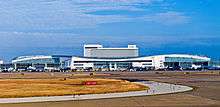

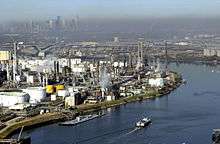
Part of the state's tradition of cowboys is derived from the massive cattle drives which its ranchers organized in the nineteenth century to drive livestock to railroads and markets in Kansas, for shipment to the East. Towns along the way, such as Baxter Springs, the first cow town in Kansas, developed to handle the seasonal workers and tens of thousands of head of cattle being driven.
The first railroad to operate in Texas was the Buffalo Bayou, Brazos and Colorado Railway, opening in August 1853.[338] The first railroad to enter Texas from the north, completed in 1872, was the Missouri–Kansas–Texas Railroad.[339] With increasing railroad access, the ranchers did not have to take their livestock up to the Midwest and shipped beef out from Texas. This caused a decline in the economies of the cow towns.
Since 1911, Texas has led the nation in length of railroad miles within the state. Texas railway length peaked in 1932 at 17,078 miles (27,484 km), but declined to 14,006 miles (22,540 km) by 2000. While the Railroad Commission of Texas originally regulated state railroads, in 2005 the state reassigned these duties to TxDOT.[340]
In the Dallas–Fort Worth area, three public transit agencies provide rail service: Dallas Area Rapid Transit (DART), Denton County Transportation Authority (DCTA), and Trinity Metro. DART began operating the first light rail system in the Southwest United States in 1996.[341] The Trinity Railway Express (TRE) commuter rail service, which connects Fort Worth and Dallas, is provided by Trinity Metro and DART.[342] Trinity Metro also operates the TEXRail commuter rail line, connecting downtown Fort Worth and Northeast Tarrant County to DFW Airport.[343] The A-train commuter rail line, operated by DCTA, acts as an extension of the DART Green line into Denton County.[344] In the Austin area, Capital Metropolitan Transportation Authority operates a commuter rail service known as Capital MetroRail to the northwestern suburbs. The Metropolitan Transit Authority of Harris County, Texas (METRO) operates light rail lines in the Houston area.
Amtrak provides Texas with limited intercity passenger rail service. Three scheduled routes serve the state: the daily Texas Eagle (Chicago–San Antonio); the tri-weekly Sunset Limited (New Orleans–Los Angeles), with stops in Texas; and the daily Heartland Flyer (Fort Worth–Oklahoma City). Texas may get one of the nation's first high-speed rail line. Plans for a privately funded high-speed rail line between Dallas and Houston have been planned by the Texas Central Railway company.
Sports
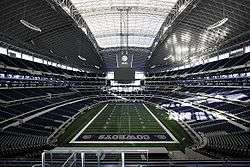
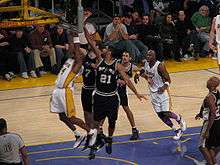
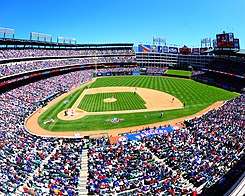
While American football has long been considered "king" in the state, Texans enjoy a wide variety of sports.[345]
Texans can cheer for a plethora of professional sports teams. Within the "Big Four" professional leagues, Texas has two NFL teams (the Dallas Cowboys and the Houston Texans), two Major League Baseball teams (the Houston Astros and the Texas Rangers), three NBA teams (the San Antonio Spurs, the Houston Rockets, and the Dallas Mavericks), and one National Hockey League team (the Dallas Stars). The Dallas–Fort Worth metroplex is one of only twelve American metropolitan areas that host sports teams from all the "Big Four" professional leagues. Outside the "Big Four", Texas also has a WNBA team, (the Dallas Wings) and two Major League Soccer teams (the Houston Dynamo and FC Dallas).
Collegiate athletics have deep significance in Texas culture, especially football. The state has twelve Division I-FBS schools, the most in the nation. Four of the state's universities, the Baylor Bears, Texas Longhorns, TCU Horned Frogs, and Texas Tech Red Raiders, compete in the Big 12 Conference. The Texas A&M Aggies left the Big 12 and joined the Southeastern Conference in 2012, which led the Big 12 to invite TCU to join; TCU was previously in the Mountain West Conference. The Houston Cougars and the SMU Mustangs compete in the American Athletic Conference. The Texas State Bobcats and the UT Arlington Mavericks compete in the Sun Belt Conference. Four of the state's schools claim at least one national championship in football: the Texas Longhorns, the Texas A&M Aggies, the TCU Horned Frogs, and the SMU Mustangs.
According to a survey of Division I-A coaches the rivalry between the University of Oklahoma and the University of Texas at Austin, the Red River Shootout, ranks the third-best in the nation.[346] The TCU Horned Frogs and SMU Mustangs also share a rivalry and compete annually in the Battle for the Iron Skillet. A fierce rivalry, the Lone Star Showdown, also exists between the state's two largest universities, Texas A&M University and the University of Texas at Austin. The athletics portion of the Lone Star Showdown rivalry has been put on hold after the Texas A&M Aggies joined the Southeastern Conference.
The University Interscholastic League (UIL) organizes most primary and secondary school competitions. Events organized by UIL include contests in athletics (the most popular being high school football) as well as artistic and academic subjects.[347]
Texans also enjoy the rodeo. The world's first rodeo was hosted in Pecos, Texas.[348] The annual Houston Livestock Show and Rodeo is the largest rodeo in the world. It begins with trail rides from several points throughout the state that convene at Reliant Park.[349] The Southwestern Exposition and Livestock Show in Fort Worth is the oldest continuously running rodeo incorporating many of the state's most historic traditions into its annual events. Dallas hosts the State Fair of Texas each year at Fair Park.[350]
Texas Motor Speedway hosts annual NASCAR Cup Series and IndyCar Series auto races since 1997. Since 2012, Austin's Circuit of the Americas plays host to a round of the Formula 1 World Championship—[351] the first at a permanent road circuit in the United States since the 1980 Grand Prix at Watkins Glen International—, as well as Grand Prix motorcycle racing, FIA World Endurance Championship and United SportsCar Championship races.
Notes
- As used by the large Grand Prairie-based national and international amusement park operator Six Flags, among others.
References
- Plocheck, Robert (November 20, 2017). Facts. Texas Almanac (2010–2011 ed.). Archived from the original on February 28, 2011.
- Environment. Texas Almanac. 2008. Retrieved June 28, 2020.
- "El Capitan". NGS data sheet. U.S. National Geodetic Survey. Retrieved October 20, 2011.
- "Elevations and Distances in the United States". United States Geological Survey. 2001. Archived from the original on July 22, 2012. Retrieved October 24, 2011.
- Elevation adjusted to North American Vertical Datum of 1988.
- "USA: States (U.S. States)—Population Statistics, Charts and Map". citypopulation.de.
- "National Population Totals and Components of Change: 2010-2019". U.S. Census Bureau. January 9, 2020. Retrieved January 9, 2020.
- "Median Annual Household Income". The Henry J. Kaiser Family Foundation. Retrieved December 9, 2016.
- Texas—Languages. MLA. Retrieved April 15, 2010.
- Wells, John C. (1982). Accents of English. Volume 3: Beyond the British Isles (pp. i–xx, 467–674). Cambridge University Press. p. 551. ISBN 0-52128541-0.
- "Introduction to Texas". Netstate.com. Retrieved April 11, 2010.
- Hanson-Harding, Alexandra (2001). Texas. Children's Press. ISBN 978-0-516-22322-3.
- Sansom, Andrew (2008). Water in Texas: An Introduction. University of Texas Press. p. 25. ISBN 978-0-292-71809-8.
- Dingus, Anne (1987). The dictionary of Texas misinformation. Texas Monthly Press. ISBN 978-0-87719-089-9.
- "Resolutions" (PDF). Twenty-ninth Congress. 1845. Archived from the original (PDF) on May 25, 2017. Retrieved May 16, 2017.
- Ramos, Mary G.; Reavis, Dick J. (2004). Texas. Fodor's Travel Publications. p. 125. ISBN 978-0-676-90502-1.
- Hackett, Robert (June 15, 2015). "States with the most Fortune 500 companies". Fortune. Time Inc.
- José Arlegui, Chronica de la provincia de N.S.P.S. Francisco de Zacatecas Front Cover (1737), p. 53.
- Davis, Lucile (2003). Caddo of Texas. Rosen Publishing. p. 5. ISBN 9780823964352.
- William Bright, Native American Placenames of the United States, University of Oklahoma Press (2004), p. 491.
- Weber, David J. (1992), The Spanish Frontier in North America, Yale Western Americana Series, New Haven, Connecticut: Yale University Press, p. 154.
- Teja, Jesús de la (June 15, 2010). "New Philippines". Handbook of Texas (online ed.). Texas State Historical Association.
- Oakah L. Jones, Los Paisanos: Spanish Settlers on the Northern Frontier of New Spain, University of Oklahoma Press (1996), p. 277, citing a document dated November 5, 1730.
- Joseph de Laporte, El viagero universal: Ó, Noticia del mundo antiguo y nuevo vol. 27 (1799), p. 114.
- "Texas. Grafía recomendada para el nombre de este estado norteamericano. Su pronunciación correcta es [téjas], no [téksas]. Se recomienda escribir asimismo con x el gentilicio correspondiente: texano. Son también válidas las grafías con j (Tejas, tejano), de uso mayoritario en España." Diccionario panhispánico de dudas, Real Academia Española (2005), s.v. Texas.
- Charles Dimitry, "American Geographical Nomenclature", Appletons' Journal 15 (1876), 758f.
- Griffin, Roger A. (March 21, 2016) [June 12, 2010]. "Compromise of 1850". Handbook of Texas (online ed.). Texas State Historical Association.
- "Tx Environmental Profiles". Archived from the original on June 3, 2008. Retrieved July 14, 2006.
- "Rivers in Texas". Tpwd.state.tx.us. November 16, 2007. Retrieved April 11, 2010.
- Bybee, Hal P. (June 15, 2010). "Rivers". Handbook of Texas (online ed.). Texas State Historical Association.
- "Alphabetical List of Texas Lakes". Tpwd.state.tx.us. January 28, 2010. Retrieved April 11, 2010.
- Nova Lomax, John (March 3, 2015). "Is Texas Southern, Western, or Truly a Lone Star?". Texas Monthly. Retrieved September 6, 2016.
- Muzzafar, Asif. Timing of Diapir Growth and Cap Rock Formation, Davis Hill Salt Dome, Coastal Texas. GSA Annual Meeting, November 5–8, 2001. The Geological Society of America. Archived from the original on September 7, 2008. Retrieved July 22, 2008.
- "Ogallala Aquifer". North Plains Groundwater Conservation District. Archived from the original on July 4, 2008. Retrieved July 23, 2008.
- "Earthquakes". Jackson School of Geosciences—University of Texas. Archived from the original on May 1, 2008. Retrieved July 23, 2008.
- "Texas Wildlife Identification & Viewing Guide". Wildtexas.com. December 3, 2010. Retrieved April 18, 2013.
- "Texas Mammals". The Mammals of Texas—Online Edition. Natural Science Research Laboratory—Museum of Texas Tech University. Archived from the original on May 8, 2013. Retrieved April 18, 2013.
- West, Mary Jane (1968). "Range Extension and Solitary nest founding in Polistes Exclamans". Psyche. 75 (2): 118–123. doi:10.1155/1968/49846.
- "El Paso, Texas Travel Weather Averages". Weatherbase. Retrieved April 18, 2013.
- "Mauriceville, Texas Travel Weather Averages". Weatherbase. Retrieved April 18, 2013.
- "History : Weather Underground". Wunderground.com. December 24, 2008. Retrieved April 11, 2010.
- "Monthly Averages for Marfa, Texas". The Weather Channel. Retrieved October 15, 2008.
- "Monthly Averages for Galveston, Texas". The Weather Channel. Retrieved October 15, 2008.
- "Texas climate averages". Weatherbase. Retrieved November 10, 2015.
- NOOA.gov Archived April 23, 2017, at the Wayback Machine National Climatic Data Center. Retrieved on October 24, 2006.
- Bomar, George W. (June 15, 2010). "Weather". Handbook of Texas (online ed.). Texas State Historical Association.
- Blake, Eric S.; Rappaport, Edward N.; Landsea, Christopher W. (April 15, 2007). "The Deadliest, Costliest, and Most Intense United States Tropical Cyclones From 1851 to 2006" (PDF). National Weather Service: National Hurricane Center.
- Hicks, Michael; Burton, Mark (September 8, 2017). Hurricane Harvey: Preliminary Estimates of Commercial and Public Sector Damages on the Houston Metropolitan Area (PDF) (Report). Ball State University. Retrieved November 1, 2017.
- "Rankings: Total Carbon Dioxide Emissions, 2017". U.S. Energy Information Administration. 2017. Retrieved January 14, 2020.
- "Texas No. 1 producer of greenhouse gases". The Dallas Morning News. Associated Press. June 3, 2007. Archived from the original on September 19, 2008. Retrieved June 11, 2008.
- "Living, and coughing, downwind of Texas smoke stacks". Raw Story. Agence France-Presse. November 10, 2011.
- Richardson (2005), p. 9.
- Richardson (2005), pp 10–16
- Klos, George (June 15, 2010). "Indians". Handbook of Texas (online ed.). Texas State Historical Association.
- Fry, Phillip L. (March 7, 2016) [July 15, 2010]. "Texas, Origin of Name". Handbook of Texas (online ed.). Texas State Historical Association.
- Richardson, p 1
- "Texas". Online Etymology Dictionary. Douglas Harper. Retrieved February 25, 2007.
- Wallace Chafe, p.c.
- Glover, William B. "A History of the Caddo Indians". Reprinted from 'The Louisiana Historical Quarterly'; Vol. 18, No. 4. October 1935
- Swanton, John R. Indians of the Southeastern United States (Washington: United States Government Printing Office, 1946) p. 139
- Richardson, p 10
- Richardson, Rupert N.; Anderson, Adrian; Wintz, Cary D.; Wallace, Ernest (2005). Texas: the Lone Star State (9th ed.). Prentice Hall. pp. 10–16. ISBN 978-0-1318-3550-4.
- Chipman (1992), p. 243; Weber (1992), p. 34
- Chipman, Donald E. (August 3, 2017) [June 12, 2010]. "Álvar Núñez Cabeza de Vaca". Handbook of Texas (online ed.). Texas State Historical Association.
- Chipman, Donald E. (January 23, 2017) [June 15, 2010]. "Spanish Texas". Handbook of Texas (online ed.). Texas State Historical Association.
- "The Journey of Alvar Nuńez Cabeza de Vaca". American Journeys. Wisconsin Historical Society. Archived from the original on October 5, 2012.
- Davidson, James West; Lytle, Mark H (2010). "Chapter 1". After the Fact: The Art of Historical Detection. Volume 1 (6th ed.). New York: McGraw Hill. p. 7. ISBN 978-0-0733-8548-8.
- Winship, George Parker, ed. (1904). The Journey of Coronado, 1540–1542. New York: A.S. Barnes & Company. pp. 210–211.
- Weber (1992), p. 149.
- Chipman (1992), p. 83.
- Chipman (1992), p. 89.
- Weber (1992), p. 155.
- Chipman (1992), pp. 111–112; Weber (1992), p. 160
- Weber (1992), p. 163.
- Bolton, Herbert Eugene (1915). Texas in the Middle 18th Century. Berkeley: University of California Press. p. facing p. 382.
- Chipman (1992), p. 205.
- Weber (1992), p. 193.
- Weber (1992), p. 189.
- Weddle (1995), p. 163.
- Weddle (1995), p. 164; Chipman (1992), p. 200
- Chipman (1992), p. 202.
- Weber (1992), pp. 291–299.
- Davis (2006), p. 46.
- Weber (1992), p. 300.
- Manchaca (2001), p. 162.
- Manchaca (2001), p. 164.
- Manchaca (2001), p. 198.
- Manchaca (2001), pp. 198-199.
- Edmondson (2000), p. 75.
- Manchaca (2001), p. 172, 201.
- http://www.publishinghau5.com/The-History-of-Texas-page-9.php%5B%5D
- Edmondson (2000), p. 78.
- Manchaca, Martha (2001). Recovering History, Constructing Race: The Indian, Black, and White Roots of Mexican Americans. The Joe R. and Teresa Lozano Long Series in Latin American and Latino Art and Culture. Austin, TX: University of Texas Press. p. 200. ISBN 0-292-75253-9.
- Davis (2006), p. 77.
- Davis (2006), p. 85.
- Davis (2006), pp. 86–89.
- Davis (2006), p. 92.
- Steen, Ralph W. (June 12, 2010). "Convention of 1833". Handbook of Texas (online ed.). Texas State Historical Association.
- Huson, Hobart (1974). Captain Phillip Dimmitt's Commandancy of Goliad, 1835–1836: An Episode of the Mexican Federalist War in Texas, Usually Referred to as the Texian Revolution. Austin, Texas: Von Boeckmann-Jones Co. p. 4.
- Hardin (1994), p. 12.
- Barr (1990), p. 64.
- Winders (2004), p. 72.
- Winders (2004), pp. 90, 92Hardin (1994), p. 109
- Hardin (1994), p. 102.
- Roell, Craig H. (July 12, 2016) [June 12, 2010]. "Coleto, Battle of". Handbook of Texas (online ed.). Texas State Historical Association.
- Todish, Todish & Spring (1998), p. 68.
- Roberts and Olson (2001), p. 144.
- Todish, Todish & Spring (1998), p. 69.
- Todish, Todish & Spring (1998), p. 70.
- "The Archives War". Texas Treasures- The Republic. The Texas State Library and Archives Commission. November 2, 2005. Retrieved January 3, 2009.
- Andrew J. Torget (2015). Seeds of Empire: Cotton, Slavery, and the Transformation of the Texas Borderlands, 1800-1850. The University of North Carolina Press. ISBN 978-1469624242.
- Calvert, Robert A.; León, Arnoldo De; Cantrell, Gregg (2002). The History of Texas. Harlan Davidson. ISBN 978-0-88295-966-5.
- Winders, Richard Bruce (2002). Crisis in the Southwest: The United States, Mexico, and the Struggle Over Texas. Rowman & Littlefield. p. 41. ISBN 978-0-8420-2801-1.
- Buescher, John. "Senatorial Division", Teachinghistory.org, accessed August 21, 2011. Archived July 11, 2011, at the Wayback Machine
- Neu, C. T. (December 2, 2015) [June 9, 2010]. "Annexation". Handbook of Texas (online ed.). Texas State Historical Association.
- Bauer, K. Jack (March 28, 2016) [June 15, 2010]. "Mexican War". Handbook of Texas (online ed.). Texas State Historical Association.
- Britton, Karen Gerhardt; Elliott, Fred C.; Miller, E. A. (June 12, 2010). "Cotton Culture". Handbook of Texas (online ed.). Texas State Historical Association.
- Schulte, Susan (December 9, 2010). "Visualizing Slavery: A Map of Slavery Interactive Feature". The New York Times.
- Dulaney, W. Marvin (July 25, 2016) [June 9, 2010]. "African Americans". Handbook of Texas (online ed.). Texas State Historical Association.
- Buenger, Walter L. (March 8, 2011) [June 15, 2010]. "Secession Convention". Handbook of Texas (online ed.). Texas State Historical Association.
- Kreneck, Thomas H. (March 30, 2017) [June 15, 2010]. "Houston, Samuel". Handbook of Texas (online ed.). Texas State Historical Association.
- Wooster, Ralph A. (January 30, 2017) [June 12, 2010]. "Civil War". Handbook of Texas (online ed.). Texas State Historical Association.
- Federal Writers' Project (December 1997). Texas, A Guide to the Lone Star State: Brownsville. Native American Books Distributor. p. 206. ISBN 978-0-403-02192-5.
- Hunt, Jeffrey William (April 4, 2016) [June 15, 2010]. "Palmito Ranch, Battle of". Handbook of Texas (online ed.). Texas State Historical Association.
- "Historical Barriers to Voting". Texas Politics. University of Texas. Archived from the original on April 2, 2008. Retrieved October 13, 2008.
- Acosta, Teresa Palomo (October 6, 2017) [June 15, 2010]. "Juneteenth". Handbook of Texas (online ed.). Texas State Historical Association.
- Johnson, Andrew (August 20, 1866). Proclamation Declaring the Insurrection at an End. American Historical Documents. President of the United States. Retrieved April 28, 2008.
- Moneyhon, Carl H. (January 30, 2017) [June 15, 2010]. "Restoration". Handbook of Texas (online ed.). Texas State Historical Association.
- Wooster, Robert; Sanders, Christine Moor (July 26, 2016) [June 15, 2010]. "Spindletop Oilfield". Handbook of Texas (online ed.). Texas State Historical Association.
- Olien, Roger M. (August 19, 2016) [June 15, 2010]. "Oil and Gas Industry". Handbook of Texas (online ed.). Texas State Historical Association.
- "Nixon v. Condon. Disfranchisement of the Negro in Texas". The Yale Law Journal. 41 (8): 1212–1221. June 1932. doi:10.2307/791091. JSTOR 791091.
- "Texas Politics: Historical Barriers to Voting". University of Texas at Austin. 2006. Archived from the original on April 2, 2008.
- Alwyn, Barr (June 15, 2010). "Socialist Party". Handbook of Texas (online ed.). Texas State Historical Association.
- Jillson, Cal (2011). Texas Politics: Governing the Lone Star State. Taylor & Francis. p. 11. ISBN 978-0-203-82941-7.
- Lee, James Ward; Barnes, Carolyn N.; Bowman, Kent Adam (1991). 1941: Texas Goes to War. University of North Texas Press. ISBN 978-0-929398-29-7.
- Fairchild, Louis (2012). They Called It the War Effort: Oral Histories from World War II Orange, Texas (second ed.). Texas A&M University Press. ISBN 978-0-87611-259-5.
- Peck, Merton J.; Scherer, Frederic M. (1962). The weapons acquisition process: an economic analysis. Division of Research, Graduate School of Business Administration, Harvard University. p. 111.
- Blanton, Carlos Kevin (2005). "The Campus and the Capitol: John B. Connally and the Struggle over Texas Higher Education Policy, 1950–1970". Southwestern Historical Quarterly. 108 (4): 468–497. ISSN 0038-478X.
- Greenberg, Bradley S.; Parker, Edwin B. (1965). The Kennedy Assassination and the American Public: Social Communication in Crisis. Stanford University Press. p. 187.
- Calvert, Robert A. (January 30, 2017) [June 15, 2010]. "Texas Since World War II". Handbook of Texas (online ed.). Texas State Historical Association.
- "Bill of Rights (Article 1)". Texas Politics. University of Texas. Archived from the original on February 6, 2009. Retrieved October 13, 2008.
- "The Plural Executive". Texas Politics. University of Texas. 2005. Archived from the original on September 28, 2008. Retrieved May 7, 2008.
- "Membership". Texas Politics. University of Texas. 2005. Archived from the original on March 2, 2009. Retrieved June 17, 2008.
- "Special Sessions". Texas Politics. University of Texas. 2005. Archived from the original on March 2, 2009. Retrieved June 17, 2008.
- Womack, Paul (June 15, 2010). "Judiciary". Handbook of Texas (online ed.). Texas State Historical Association.
- Procter, Ben H. (February 8, 2018) [June 15, 2010]. "Texas Rangers". Handbook of Texas (online ed.). Texas State Historical Association.
- African-American Pioneers of Texas: From the Old West to the New Frontiers (Teacher's Manual) (PDF). Museum of Texas Tech University: Education Division. p. 25. Archived from the original (PDF) on February 5, 2007.
- "Political Parties". Handbook of Texas (online ed.). Texas State Historical Association. June 15, 2010.
- Risen, Clay (March 5, 2006). "How the South was won". The Boston Globe. Retrieved April 29, 2008.
- "History of Texas Voters". NewsChannel10. KFDA-TV. November 8, 2016. Retrieved December 16, 2016.
- "How Texas Became a "Red" State". Frontline. PBS. April 12, 2005. Retrieved December 16, 2016.
- "The Texas Gerrymander". The New York Times. March 1, 2006.
- Ridder, Knight (July 29, 2003). "11 Texas Senate Democrats Take Cue from House, Bolt to Avoid Redistricting". Houston Chronicle. Retrieved January 7, 2009.
- "Justices Back Most G.O.P. Changes to Texas Districts". The New York Times. The Associated Press. June 28, 2006.
- Fernandez, Manny (May 27, 2014). "Lieutenant Governor Loses Texas Runoff as Tea Party Holds Sway". The New York Times.
- Koppel, Nathan (January 21, 2015). "Texas Lt. Gov. Dan Patrick Moves Quickly to Advance Conservative Agenda". The Wall Street Journal.
- Grissom, Brandi (May 28, 2014). "Tea Party Conservatives Win Top GOP Runoff Contests". The Texas Tribune.
- Fernandez, Manny (January 20, 2015). "Texas' New Governor Echoes the Plans of Perry". The New York Times.
- "Texas Political Culture—Introduction". Texas Politics. University of Texas. Archived from the original on December 20, 2008. Retrieved May 29, 2008.
- "Texas Political Culture—Low Taxes, Low Services Political Culture". Texas Politics. University of Texas. Archived from the original on January 30, 2009. Retrieved October 13, 2008.
- "Report focusing on the political persuasion of Hispanic and Latino voters". CNN. Retrieved May 30, 2012.
- "2000 Presidential General Election Results—Texas". US Election Atlas. Retrieved July 22, 2008.
- "2004 Presidential General Election Results—Texas". uselectionatlas.org. Retrieved July 22, 2007.
- Shoichet, Catherine E. (May 9, 2019). "Florida is about to ban sanctuary cities. At least 11 other states have, too". CNN.
- "U.S. Cities Prepare For Planned ICE Raids". NPR. July 13, 2019.
- "Race Summary Report, 2016 General Election". Texas Secretary of State. Retrieved December 1, 2016.
- McDonald, John V. (August 2000). An Analysis of Texas' Municipal Home Rule Charters Since 1994" (Thesis). Texas State University.
- "Run for Party Nomination to Public Office". Texas Politics. University of Texas. Archived from the original on March 18, 2009. Retrieved October 12, 2008.
- "Texas executes 500th person since resuming death penalty". BBC News. June 27, 2013. Retrieved July 8, 2013.
- Sabol, William J.; West, Heather C.; Cooper, Matthew (December 2009). "Prisoners in 2008" (PDF). Bureau of Justice Statistics Bulletin.
- "TEX PE. CODE ANN. § 9.42 : Texas Statutes—Section 9.42: DEADLY FORCE TO PROTECT PROPERTY". Codes.lp.findlaw.com. Retrieved July 8, 2013.
- "Gross Domestic Product by State, Annual 2019" (PDF). Bureau of Economic Analysis. Arpil 7, 2020. Retrieved June 9, 2019. Check date values in:
|date=(help) - "Report for Selected Countries and Subjects". International Monetary Fund. Retrieved June 8, 2019.
- "Economic Geography". Texas Politics. University of Texas. Archived from the original on April 30, 2009. Retrieved October 13, 2008.
- "Local Area Unemployment Statistics". Bureau of Labor Statistics. Retrieved July 3, 2020.
- "Site Selection Rankings". Retrieved October 10, 2011.
- "Fortune 500 2010: States: Texas Companies". FORTUNE on CNNMoney.com. CNN. May 3, 2010. Retrieved August 15, 2011.
- "Fortune 500 2010: States: California Companies". FORTUNE on CNNMoney.com. CNN. May 3, 2010. Retrieved August 15, 2011.
- Second to California
- Scott, Walter (May 2, 2010). "Personality Parade". Parade Magazine. p. 2.
- "Texas". Research Areas. The Tax Foundation. 2010. Retrieved October 15, 2010.
- "State Individual Income Taxes". Federation of Tax Administrators. Archived from the original on October 3, 2008. Retrieved October 12, 2008.
- "Why does Texas (Taxus) have the highest property taxes and 3rd highest sales tax?". Alltaxtips.com. May 9, 2011. Archived from the original on July 7, 2011. Retrieved August 15, 2011.
- "FAQ: Texas Sales Tax". Window.state.tx.us. Retrieved January 10, 2011.
- Story, Louise (December 1, 2012). "Lines Blur as Texas Gives Industries a Bonanza". The New York Times.
- "UNITED STATES OF SUBSIDIES, Texas". The New York Times. December 1, 2012.
- "The Texas Economy". netstate.com. June 5, 2007. Retrieved April 29, 2008.
- Electronic Municipal Market Access (2013). "Appendix A" (PDF). The State of Texas. Washington, D.C.: Municipal Securities Rulemaking Board (MSRB). Retrieved October 23, 2016.
- "Crop Production: 2014 Summary" (PDF). United States Department of Agriculture. pp. 48–49. Retrieved July 23, 2015.
- Carmack, Liz (June 21, 2013). "The Legacy of 'King Cotton'". County. Texas Association of Counties. Retrieved July 23, 2015.
- Marsh, Wendell (August 5, 2011). "No relief in sight for Texas heat and drought". Reuters. Retrieved January 13, 2013.
- Ramos, Mary G. (November 29, 2017). "Oil and Texas: A Cultural History". Texas Almanac 2000–2001. The Texas State Historical Association. Retrieved July 3, 2018.
- Alexander Kent (July 28, 2014). "The 10 Most Oil-Rich States". 24/7 Wall Street. Retrieved August 5, 2014.
- Prindle, David F. (June 15, 2010). "Railroad Commission". Handbook of Texas (online ed.). Texas State Historical Association.
- "Petroleum Profile: Texas". Energy Information Administration. Archived from the original on February 4, 2011. Retrieved December 13, 2008.
- "Texas State Energy Profile: Electricity". U.S. Energy Information Administration. Retrieved July 23, 2015.
Texas produces more electricity than any other state, generating almost twice as much as the next largest generating state.
- "Electricity Data Browser: Net generation from electricity plants for all fuels, annual". Energy Information Administration.
- Souder, Elizabeth (January 2008). "Texas leads nation in wind power capacity". The Dallas Morning News.
- Clark, Stacy (December 6, 2017). "Hold Onto Your Bonnets! Breezes and Sunshine to Power Georgetown, TX". Huffington Post.
- O'Grady, Eileen (October 1, 2009). "E.ON completes world's largest wind farm in Texas". Reuters. Retrieved August 26, 2010.
- "Locations". Lockheed Martin. Archived from the original on April 22, 2008. Retrieved May 22, 2008.
- "About Bell Helicopter". Bell Helicopter. Archived from the original on June 2, 2008. Retrieved May 22, 2008.
- Rosenwald, Michael S. (December 17, 2007). "Downside of Dominance?". The Washington Post. Retrieved May 22, 2008.
- "Texas". Fortune Magazine. April 30, 2007. Retrieved May 3, 2008.
- "Dallas Shopping". Dallas Convention & Visitors Bureau. Retrieved June 26, 2016.
- "Recent Economic Transformations". Texas Politics. University of Texas. Archived from the original on April 30, 2009. Retrieved October 13, 2008.
- Resident Population Data. "Resident Population Data—2010 Census". 2010.census.gov. Archived from the original on October 19, 2013. Retrieved December 22, 2012.
- "Table 1. Annual Estimates of the Resident Population for the United States, Regions, States, and Puerto Rico: April 1, 2010 to July 1, 2019". U.S. Census Bureau. January 9, 2020. Retrieved January 9, 2020.
- "Immigrants in Texas" (PDF). American Immigration Council. 2017.
- Hennessy-Fiske, Molly; Carcamo, Cindy (June 16, 2014). "In Texas' Rio Grande Valley, a seemingly endless surge of immigrants". Los Angeles Times.
- Miroff, Nick; Partlow, Joshua (June 12, 2014). "Central American migrants overwhelm Border Patrol station in Texas". Washington Post.
- Estimates of the Population by Age, Sex, and Race/Ethnicity for July 1, 2015 for State of Texas. Texas Demographic Center, U.S. Bureau of the Census State Data Center Program (PDF), July 15, 2015, archived from the original (PDF) on May 4, 2017, retrieved June 8, 2017
- Data Access and Dissemination Systems (DADS). "American FactFinder—Results". census.gov. Archived from the original on February 12, 2020.
- "US Census Bureau: Table QT-P10 Hispanic or Latino by Type: 2010". Factfinder2.census.gov. October 5, 2010. Archived from the original on January 25, 2015. Retrieved August 2, 2014.
- Exner, Rich (June 3, 2012). "Americans under age 1 now mostly minorities, but not in Ohio: Statistical Snapshot". The Plain Dealer.
- "Historical Census Statistics on Population Totals By Race, 1790 to 1990, and By Hispanic Origin, 1970 to 1990, For The United States, Regions, Divisions, and States". Census.gov. Archived from the original on July 25, 2008. Retrieved August 2, 2014.
- "Population of Texas: Census 2010 and 2000 Interactive Map, Demographics, Statistics, Quick Facts".
- 2010 Census Data. "2010 Census Data". Census.gov. Retrieved August 2, 2014.
- "Ancestry of the Population by State: 1980—Table 3" (PDF). Retrieved July 8, 2013.
- Colin Bonwick, The American Revolution, 1991, p. 254
- Lieberson, Stanley & Waters, Mary C. (1986). "Ethnic Groups in Flux: The Changing Ethnic Responses of American Whites". Annals of the American Academy of Political and Social Science. 487 (79): 82–86. doi:10.1177/0002716286487001004.
- Fischer, David Hackett (1989). Albion's Seed: Four British Folkways in America. New York: Oxford University Press. pp. 633–639. ISBN 978-0-19-503794-4.
- "Czech language" (PDF). U.S. English. Archived from the original (PDF) on March 4, 2012. Retrieved May 11, 2013.
- "Texas—ACS Demographic and Housing Estimates: 2006–2008". Factfinder.census.gov. Archived from the original on February 11, 2020. Retrieved January 10, 2011.
- "Texas—Selected Social Characteristics in the United States: 2006–2008". Factfinder.census.gov. Archived from the original on February 11, 2020. Retrieved January 10, 2011.
- Frey, William H. (May 2004). The New Great Migration: Black Americans' Return to the South, 1965–2000 (Report). The Brookings Institution. p. 1. Archived (PDF) from the original on April 28, 2008.
- "Texas".
- Castillo, Juan (November 17, 2011). "Hispanics make up nearly half of all Texas births in 2010, U.S. says". Austin American-Statesman. Archived from the original on November 20, 2011. Retrieved November 20, 2011.
- Jervis, Rick (February 23, 2011). "Majority of Texas' population growth is Hispanic". USA Today.
- "Texas Adolescent Reproductive Health Facts". US Department of Health and Human Services. Retrieved August 2, 2014.
- "100 Largest Cities by Decade". U.S. Bureau of the Census. June 15, 1998.
- Fehrenbach, T. R. (March 30, 2017) [June 15, 2010]. "San Antonio, TX". Handbook of Texas (online ed.). Texas State Historical Association.
- McComb, David G. (May 5, 2016) [June 15, 2010]. "Galveston, TX". Handbook of Texas (online ed.). Texas State Historical Association.
- McComb, David G. (February 15, 2017) [June 15, 2010]. "Houston, TX". Handbook of Texas (online ed.). Texas State Historical Association.
- "Table 1: Annual Estimates of the Population for Incorporated Places Over 100,000, Ranked by July 1, 2006 Population: April 1, 2000 to July 1, 2006" (CSV). 2005 Population Estimates. United States Census Bureau, Population Division. June 10, 2008. Retrieved June 10, 2008.
- Neuman, Michael. "The Texas Urban Triangle: Framework for Future Growth". Southwest Region University Transportation Center (SWUTC). Archived from the original on July 5, 2009. Retrieved October 14, 2008.
- "GaWC—The World According to GaWC 2008". Globalization and World Cities Research Network. Retrieved March 1, 2009.
- Hellmann, Paul T. (February 14, 2006). "Georgia". Historical Gazetteer of the United States. Routledge. ISBN 978-1135948597. Retrieved February 16, 2017.
- Federal Reserve Bank of Dallas Office of Community Affairs. "Colonias FAQ's (Frequently Asked Questions)". Texas Secretary of State. Archived from the original on October 9, 2008. Retrieved October 12, 2008.
- Grinberg, Emmanuella. "Impoverished border town grows from shacks into community". CNN. July 8, 2011. Retrieved on July 9, 2011.
- Brinkhoff, Thomas (February 19, 2011). "Texas (USA): State, Major Cities, Towns & Places". City Population. Retrieved May 28, 2012.
- "Do You Speak American . Sea to Shining Sea . American Varieties . Texan". PBS. November 29, 2003. Retrieved August 2, 2014.
- "Do You Speak American . Sea to Shining Sea . American Varieties . Texan . Drawl". PBS. Retrieved August 2, 2014.
- Kirstin Squint, A Linguistic and Cultural Comparison of Haitian Creole and Louisiana Creole, postcolonial.org, Accessed March 11, 2014
- "Texas". Modern Language Association. Archived from the original on June 19, 2006. Retrieved August 11, 2013.
- Blatt, Ben. "Tagalog in California, Cherokee in Arkansas: What language does your state speak?". Data source: Census Bureau American Community Survey. Map by Ben Blatt/Slate. Retrieved June 2, 2014.
- Pew Research Center, "Religious Landscape Study: Texas"
- "The Association of Religion Data Archives | State Membership Report". www.thearda.com. Archived from the original on February 9, 2014. Retrieved December 12, 2013.
- Connolly, Ceci (January 21, 2003). "Texas Teaches Abstinence, With Mixed Grades". Washington Post. pp. A01. Archived from the original on October 3, 2005. Retrieved April 28, 2008.
- "Top 100 Largest Churches in America". SermonCentral.com. April 13, 2009. Retrieved April 11, 2010.
- "Texas Online: Muslim growth adds to Texas diversity". Texanonline.net. Retrieved May 7, 2012.
- Storey, John Woodrow; Kelley; Mary L. (2008). Twentieth-century Texas: a social and cultural history. University of North Texas Press. p. 145.
- Lindsey, William D.; Silk, Mark: Religion and public life in the southern crossroads: showdown states, Altamira Press, 2004, pg. 48
- "Dallas Museum Lands a Rich Trove of Islamic Art". The New York Times. February 4, 2014. Retrieved February 25, 2016.
- "Census Regions and Divisions of the United States" (PDF). United States Census Bureau. Retrieved July 2, 2016.
- Fernandez, Manny (September 14, 2013). "Not to Be, Um, Trifled With, Texas Guards Its Slogans". The New York Times. Retrieved December 29, 2013.
- "Texas-sized Hurricane Dean spins toward Yucatan". CNN.com. Archived from the original on October 10, 2008.
- "Floating, Texas-sized garbage patch threatens Pacific marine sanctuary". ars technica. Archived from the original on December 3, 2008.
- "Texas-Sized Supercomputer to Break Computing Power Record". Wired.com. June 26, 2007. Archived from the original on February 11, 2014.
- "Dems in Texas-sized showdown". ABC News.
- "A Texas-Sized Battle: Evolution vs. ID". CBNnews.com.
- Popik, Barry. "Everything's Bigger in Texas". The Big Apple online etymological dictionary. Retrieved April 7, 2015.
- Brown, Peter Jensen. "Everything is Bigger in Texas—from New York City?". Early Sports 'n' Pop-Culture History. Retrieved February 23, 2016.
- "About Houston Theater District". Houston Theater District. Archived from the original on February 29, 2008. Retrieved April 28, 2008.
- "Dallas Arts District". Dallas Convention & Visitors Bureau. Retrieved May 29, 2008.
- Maxwell, Lisa C. (November 1, 2015) [June 12, 2010]. "Deep Ellum". Handbook of Texas (online ed.). Texas State Historical Association.
- "Dallas History Items: Deep Ellum". Dallas Historical Society. Archived from the original on May 17, 2008. Retrieved July 25, 2008.
- "Live Music Capital of the World". City of Austin. Retrieved June 12, 2007.
- Bernardini, Deb. "Television's longest running concert series begins season 33 Tapings with performances by Norah Fones, Wilco, Femi Kuti, Arcade Fire and more" (PDF). Archived from the original (PDF) on October 28, 2008. Retrieved October 15, 2008.
- "About The Texas Talent Musicians Association (TTMA)". Texas Talent Musicians Association. Archived from the original on March 10, 2009. Retrieved August 2, 2009.
- "Tejano Music Awards". Texas Talent Musicians Association. 2008. Retrieved May 12, 2008.
- Smyrl, Vivian Elizabeth (June 15, 2010). "Permanent University Fund". Handbook of Texas (online ed.). Texas State Historical Association.
- Hendrickson, Kenneth E., Jr. (1995). The Chief of Executives of Texas: From Stephen F. Austin to John B. Connally, Jr. College Station, Texas: Texas A&M University Press. p. 37. ISBN 978-0-89096-641-9.
- "Comptroller Strayhorn to Review Stafford Municipal School District" (Press release). Texas Comptroller Carole Keeton Strayhorn. September 16, 2003. Archived from the original on February 22, 2004. Retrieved June 28, 2008.
- Saghaye-Biria, Hakimeh (April 22, 2001). "Robin Hood Plan is Working". World Internet News Cooperative. Archived from the original on May 11, 2008. Retrieved June 23, 2008.
- "Home School Information Letter". Texas Education Agency. November 1, 2007. Archived from the original on June 13, 2008. Retrieved June 24, 2008.
- Texas Education Agency (October 22, 2007). "End-of-Course (EOC) Assessments: Implementation". Assessment Division. Archived from the original on November 20, 2007. Retrieved October 22, 2007.
- Please note this figure refers to only the number of students paddled, regardless of whether a student was spanked multiple times in a year, and does not refer to the number of instances of corporal punishment, which would be substantially higher.
- Farrell, Colin (February 2016). "Corporal punishment in US schools". World Corporal Punishment Research. Retrieved April 4, 2016.
- "University of Texas—Austin Archived September 8, 2014, at the Wayback Machine". U.S. News & World Report. Retrieved November 17, 2013.
- "Texas A&M University—College Station Archived September 8, 2014, at the Wayback Machine". U.S. News & World Report. Retrieved November 17, 2013.
- "UH takes big step up to Tier One status". Houston Chronicle. Retrieved July 6, 2011.
- Bonnin, Richard. "Carnegie Foundation Gives University of Houston its Highest Classification for Research Success, Elevating UH to Tier One Status". University of Houston. Retrieved February 8, 2011.
- "Texas Tech University has quietly emerged as top-tier institution Archived February 9, 2014, at the Wayback Machine". San Angelo Standard-Times. Retrieved November 17, 2013.
- "Tier One/Prop. 4 Archived September 16, 2013, at the Wayback Machine". The University of Texas System. Retrieved November 17, 2013.
- "Tech and U. of Houston Qualify for Tier-One Prize Money". Texas Tribune. Retrieved November 17, 2013.
- "UTEP hits major milestone with top-tier research funding status". El Paso Times. Retrieved January 9, 2019.
- Heath, Ben (July 7, 2003). "Bill requires review of university systems" (PDF). Daily Texan. Archived from the original (PDF) on February 5, 2009. Retrieved October 12, 2007.
- "Senate Subcommittee on Higher Education Testimony Regarding the Benefits of a Stand Alone Institution" (PDF). Sam Houston State University. June 25, 2008. Archived from the original (PDF) on October 28, 2008. Retrieved October 12, 2008.
- "Tier-One Prize Money Tentatively Passes House". Retrieved April 27, 2011.
- "Rice University, Best Colleges 2009". US News and World Report. Archived from the original on February 16, 2009. Retrieved March 27, 2009.
- "Trinity University". Best Colleges 2011—US News and World Report. Archived from the original on January 19, 2012. Retrieved January 6, 2012.
- "About Baylor". Baylor University. Retrieved May 21, 2008.
- "Southwestern History". Southwestern University. Archived from the original on October 24, 2007. Retrieved October 12, 2008.
- "History". Austin College. Retrieved June 9, 2015.
- Perotin, Maria M. (June 13, 2007). "Texas is Near Bottom of Healthcare Rankings". Fort Worth Star-Telegram. Archived from the original on December 6, 2012. Retrieved April 22, 2008.
- Roberson, Jason (December 4, 2007). "Politics, poverty, immigration entangle Texas health care". The Dallas Morning News.
- "Code Red: The Critical Condition of Health in Texas". Archived from the original on May 12, 2008. Retrieved April 28, 2008.
- "Texas". State Data. Trust for America's Health. 2008. Retrieved October 14, 2008.
- "America's Fittest Cities 2007". Men's Health. 2008. Archived from the original on March 13, 2008. Retrieved April 21, 2008.
- Statemaster.com Archived June 22, 2013, at WebCite, Accessed May 16, 2007
- Redden, Molly (August 20, 2016). "Texas has highest maternal mortality rate in developed world, study finds". The Guardian. ISSN 0261-3077. Retrieved December 23, 2016.
- "Texas Medical Schools and Hospitals". Texas Medical Association. August 3, 2006. Retrieved April 28, 2008.
- "Dental Schools in the United States". Dentist.net. Retrieved October 31, 2008.
- "Accreditation Council on Optometric Education". American Optometric Association. Retrieved December 26, 2011.
- "University Selects Bioscrypt for Biosafety Level 4 Lab". Bioscrypt. October 14, 2004. Archived from the original on November 17, 2007. Retrieved April 29, 2006.
- "Biosafety Level 4 (BSL-4) Laboratory". Southwest Foundation for Biomedical Research. Archived from the original on June 29, 2007. Retrieved April 29, 2006.
- "About the Texas Medical Center". The Texas Medical Center. Archived from the original on August 10, 2007. Retrieved April 11, 2009.
- "Background Statistics > People and Politics (most recent) by state". State Master. May 8, 2008. Retrieved May 8, 2008.
- "About MD Anderson". The University of Texas M. D. Anderson Cancer Center. Archived from the original on April 24, 2008. Retrieved April 28, 2008.
- "Health Science Center ranks sixth in clinical medicine" (7 ed.). University of Texas Health Science Center. April 3, 2007. Retrieved April 28, 2008.
- "International report gives Dental School high marks". HSC NEWS. Retrieved May 15, 2008.
- "Medical center's research ranks high". San Antonio Express-News. Archived from the original on December 8, 2012. Retrieved May 15, 2008.
- "About UT Southwestern". University of Texas Southwestern Medical Center. Archived from the original on May 9, 2008. Retrieved April 28, 2008.
- "UT Southwestern Fact Sheet" (PDF). University of Texas Southwestern Medical Center. 2008. Archived from the original (PDF) on April 13, 2008. Retrieved April 28, 2008.
- "Aviation Division". Texas Department of Transportation. Retrieved July 22, 2009.
- "Transportation Division". Texas Department of Transportation. Archived from the original on May 1, 2008. Retrieved April 29, 2008.
- "5 Reasons To Choose the Dallas/Fort Worth Metroplex As A Distribution Hub" (PDF). JDF Distribution. Archived from the original (PDF) on October 28, 2008. Retrieved October 14, 2008.
- "Texas and General Foreign Trade Zones Information" (PDF). Office of the Governor of Texas. August 2007. Archived from the original (PDF) on February 14, 2015. Retrieved June 21, 2008.
- "Interstate 45 South, the Gulf Freeway". TexasFreeway.com. May 28, 2001. Retrieved October 15, 2008.
- "LoneStarRoads—Highways of Texas". AARoads. February 9, 2008. Retrieved April 20, 2008.
- "Global List of Toll Facilities—United States". International Bridge, Tunnel and Turnpike Association. 2005. Archived from the original on January 13, 2009. Retrieved April 20, 2008.
- Owens, Owens; Sunseri, Gina (October 24, 2012). "Speeding Through Texas: Going 85 MPH on the Nation's Fastest Highway". ABCNews.com. Retrieved October 28, 2012.
- "Facts about DFW". Dallas/Fort Worth International Airport. Archived from the original on September 12, 2008. Retrieved October 14, 2008.
- Jennifer LeClaire. "10 Great Places for Aviation and Aerospace". Southern Business and Development. Archived from the original on July 16, 2011. Retrieved April 28, 2008.
- "Dallas-Fort Worth International Airport". USAToday. Archived from the original on June 30, 2007. Retrieved April 28, 2008.
- Investor Relations. "American Airlines | Investor Relations | News Release". Phx.corporate-ir.net. Retrieved August 2, 2014.
- International Air Transport Association. "Scheduled Passengers Carried". Archived from the original on September 28, 2007. Retrieved June 10, 2007.
- "We Weren't Just Airborne Yesterday". Southwest Airlines. May 2, 2007. Retrieved June 9, 2007.
- "United Continental Holdings, Inc.—Investor Relations—News". Ir.unitedcontinentalholdings.com. January 8, 2014. Archived from the original on March 18, 2014. Retrieved August 2, 2014.
- Based on the industry-standard measure of revenue passenger-kilometers/miles flown.
- "About George Bush Intercontinental Airport". Houston Airport System. Archived from the original on October 13, 2007. Retrieved June 28, 2008.
- "Houston Emerges As The Premier Gateway In The U.S. For Travelers To Mexico" (Press release). Houston Airport System. April 12, 2005. Archived from the original on September 28, 2007. Retrieved December 30, 2006.
- "About Texas Ports". Texas Ports Association. Retrieved May 7, 2008.
- "Benefits of Texas Ports". Texas Ports Association. Archived from the original on July 28, 2011. Retrieved May 7, 2008.
- "General Information". The Port of Houston Authority. March 31, 2008. Archived from the original on May 9, 2008. Retrieved May 7, 2008.
- Werner, George C. (June 12, 2010). "Buffalo Bayou, Brazos and Colorado Railway". Handbook of Texas (online ed.). Texas State Historical Association.
- Hofsommer, Donovan L. (June 15, 2010). "Missouri-Kansas-Texas Railroad". Handbook of Texas (online ed.). Texas State Historical Association.
- "Former Rail Division". Texas Railroad Commission. October 1, 2005. Archived from the original on May 6, 2008. Retrieved May 4, 2008.
- Myerson, Allen R. (June 14, 1996). "Dallas Opening Southwest's First Rail Transit". New York Times. Archived from the original on September 19, 2008. Retrieved May 11, 2008.
- "Trinity Railroad Express". Retrieved June 11, 2008.
- "TEXRail to begin service Thursday after delay due to government shutdown". WFAA. January 4, 2019. Retrieved April 10, 2019.
- "DART inMotion 2011". Retrieved April 10, 2019.
- Brady, Erik (April 4, 2003). "Football still king, but hoops teams in Texas grab attention". USA TODAY. Retrieved April 11, 2008.
- Davis, Brian (October 7, 2005). "UT-OU : Best Rivalry?". The Dallas Morning News. Archived from the original on September 30, 2007. Retrieved July 11, 2006.
- "University Interscholastic League". University of Texas at Austin. Retrieved September 28, 2008.
- "View Atlas Data". Atlas.thc.state.tx.us. Archived from the original on September 4, 2015. Retrieved April 11, 2010.
- "Houston Rodeo Tickets". Houston Livestock Show and Rodeo. 2008. Retrieved April 20, 2008.
- "Fair Park, Texas". City of Dallas. Archived from the original on May 14, 2008. Retrieved May 22, 2008.
- "Formula One returns to the United States". Formula 1 Administration Ltd. Retrieved May 25, 2010.
Bibliography
- Chipman, Donald E. (1992). Spanish Texas, 1519–1821. Austin, Texas: University of Texas Press. ISBN 978-0-292-77659-3.CS1 maint: ref=harv (link)
- Davis, William C. (2006). Lone Star Rising. College Station, TX: Texas A&M University Press. ISBN 978-1-58544-532-5.CS1 maint: ref=harv (link) originally published 2004 by New York: Free Press Lone Star Rising at Google Books
- Edmondson, J. R. (2000). Alamo Story: From Early History to Current Conflicts. Republic of Texas Press. ISBN 978-1-55622-678-6.CS1 maint: ref=harv (link)
- Fehrenbach, T. R. (2000) [1968]. Lone Star: A History of Texas and the Texans. Open Road Media. ISBN 978-1-4976-0970-9.
- Hardin, Stephen L. (1994). Texian Iliad: A Military History of the Texas Revolution, 1835-1836. University of Texas Press. ISBN 978-0-292-79252-4.CS1 maint: ref=harv (link)
- Lack, Paul D. (1992). The Texas Revolutionary Experience: A Political and Social History 1835–1836. College Station, TX: Texas A&M University Press. ISBN 978-0-89096-497-2.
- Manchaca, Martha (2001). Recovering History, Constructing Race: The Indian, Black, and White Roots of Mexican Americans. The Joe R. and Teresa Lozano Long Series in Latin American and Latino Art and Culture. Austin, TX: University of Texas Press. ISBN 978-0-292-75253-5.CS1 maint: ref=harv (link)
- Todish, Timothy J.; Todish, Terry; Spring, Ted (1998). Alamo Sourcebook, 1836: A Comprehensive Guide to the Battle of the Alamo and the Texas Revolution. Austin, Texas: Eakin Press. ISBN 978-1-57168-152-2.CS1 maint: ref=harv (link)
- Report of President's Commission on the assassination of President John F. Kennedy. (1992). The Warren Commission Report. Warren Commission Hearings. IV. National Archives. ISBN 978-0-312-08257-4.
- Weber, David J. (1992). The Spanish Frontier in North America. Yale Western Americana Series. New Haven, Connecticut: Yale University Press. ISBN 978-0-300-05198-8.CS1 maint: ref=harv (link)
- Weddle, Robert S. (1995). Changing Tides: Twilight and Dawn in the Spanish Sea, 1763–1803. Centennial Series of the Association of Former Students Number 58. College Station, Texas: Texas A&M University Press. ISBN 978-0-89096-661-7.CS1 maint: ref=harv (link)
- Winders, Richard Bruce (2004). Sacrificed at the Alamo: Tragedy and Triumph in the Texas Revolution. Military History of Texas Series: Number Three. Abilene, TX: State House Press. ISBN 978-1-880510-80-3.CS1 maint: ref=harv (link)
External links
- Texas at Curlie
- The Texas State History Museum
- The Handbook of Texas Online
- Texas Register
- South and West Texas: A National Register of Historic Places Travel Itinerary
- Texas Heritage Society

- View historical photographs from Texas at the University of Houston Digital Library.
- Oklahoma Digital Maps: Digital Collections of Oklahoma and Indian Territory
State government
U.S. Government
- Energy Profile for Texas—Economic, environmental, and energy data
- USGS real-time, geographic, and other scientific resources of Texas
- Texas State Facts from USDA
- South and West Texas, a National Park Service Discover Our Shared Heritage Travel Itinerary
| Preceded by Florida |
List of U.S. states by date of statehood Admitted on December 29, 1845 (28th) |
Succeeded by Iowa |
